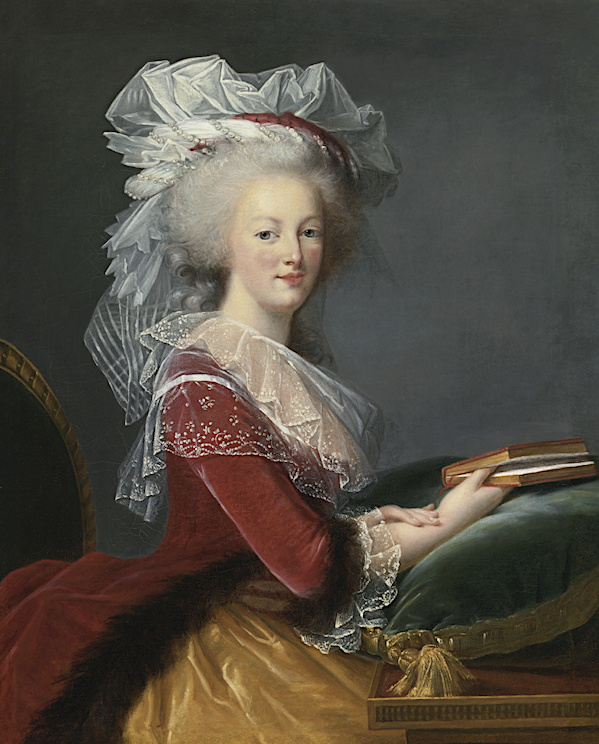Boites, tabatières, montres, étuis et autres objets précieux du XVIIIe siècle
2 participants
LE FORUM DE MARIE-ANTOINETTE :: La France et le Monde au XVIIIe siècle :: Les Arts et l'artisanat au XVIIIe siècle :: Autres
Page 1 sur 1
 Boites, tabatières, montres, étuis et autres objets précieux du XVIIIe siècle
Boites, tabatières, montres, étuis et autres objets précieux du XVIIIe siècle
Nous n'avons aucun sujet dédié aux parfums ou à ces ravissants petits objets et accessoires...Tant pis ! Je poste ici (les photos sont trop belles), et déborde à peine sur le XIXe siècle.
 C'est un objet ravissant que les amateurs du Musée Cognacq-Jay que nous sommes connaissons bien : il est souvent présenté dans les petites vitrines "à trésors" du musée...
C'est un objet ravissant que les amateurs du Musée Cognacq-Jay que nous sommes connaissons bien : il est souvent présenté dans les petites vitrines "à trésors" du musée...
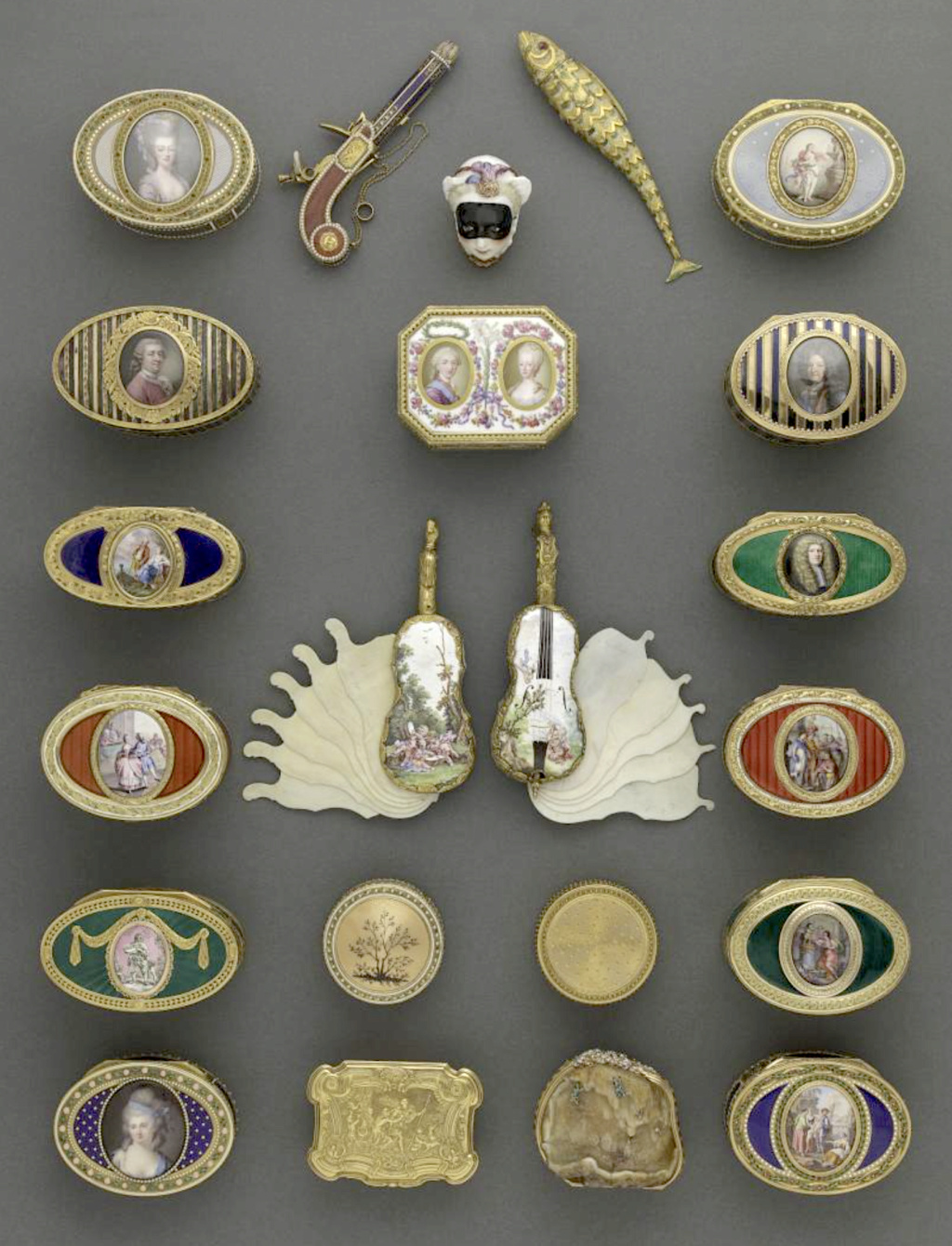
Image : Musée Cognacq-Jay, Paris
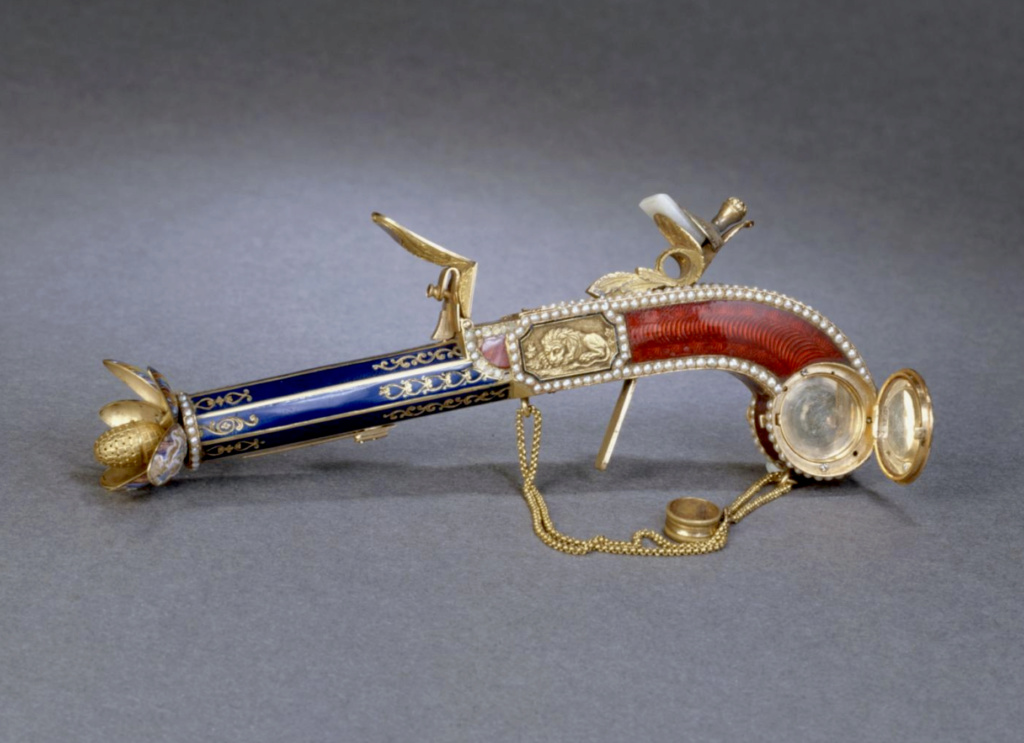
Pistolet à parfum, vaporisateur de toilette
Jean-François Bautte (1772 - 1837), orfèvre
Genève, vers 1800
Photo : Musée Cognacq-Jay
Description :
Vaporisateur à parfum en forme de pistolet. Le mécanisme d'un pistolet a été miniaturisé pour faire surgir la pomme du vaporisateur.
Le poussoir situé sous le canon du pistolet actionne le vaporisateur, qui s'avance en découvrant un bouton de fleur, lequel s'ouvre pour laisser passer le parfum à travers la pomme du vaporisateur.
Le petit réceptacle de la crosse, aujourd'hui vide, protégeait une montre minuscule.
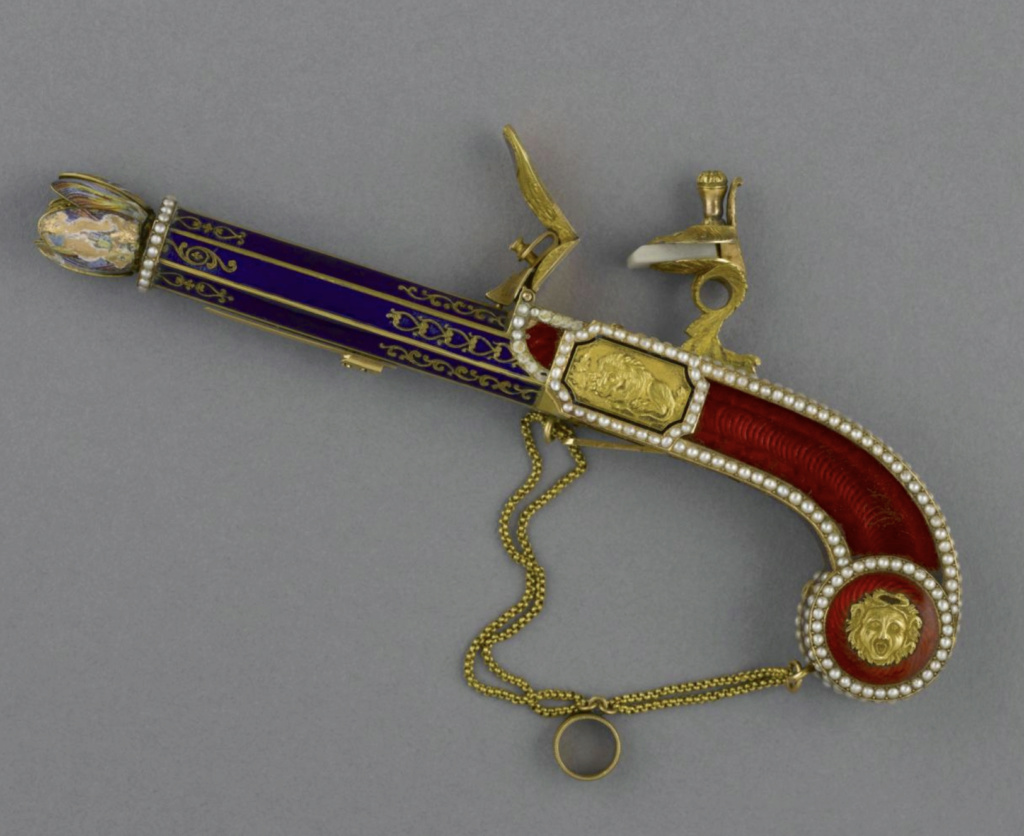
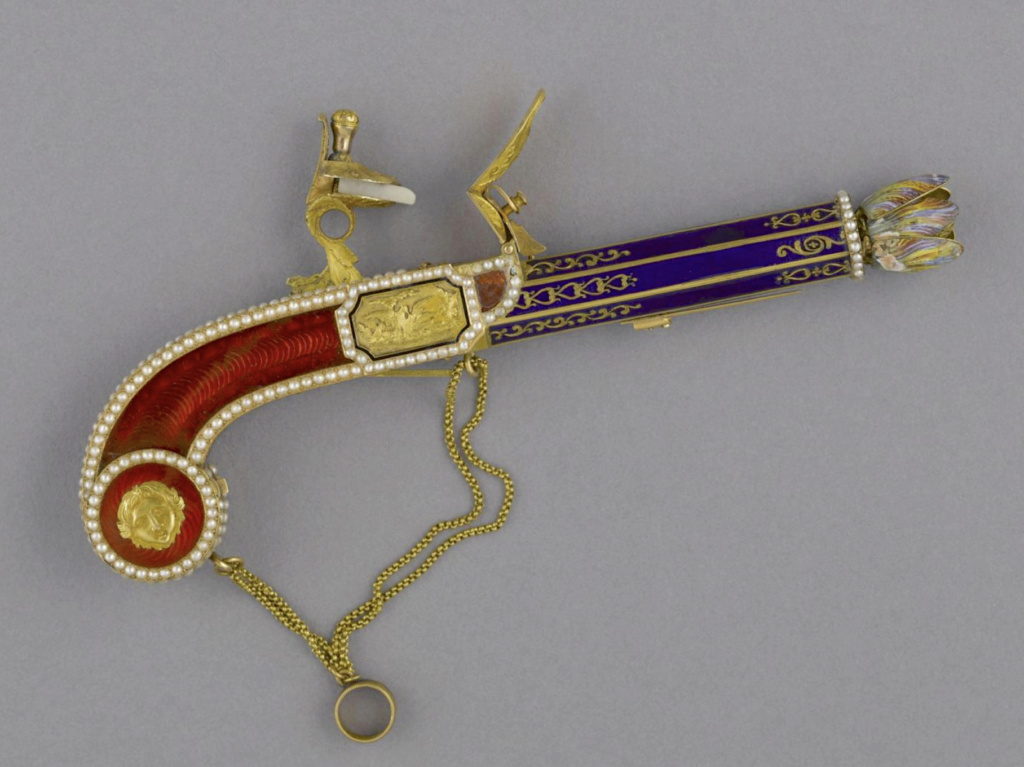
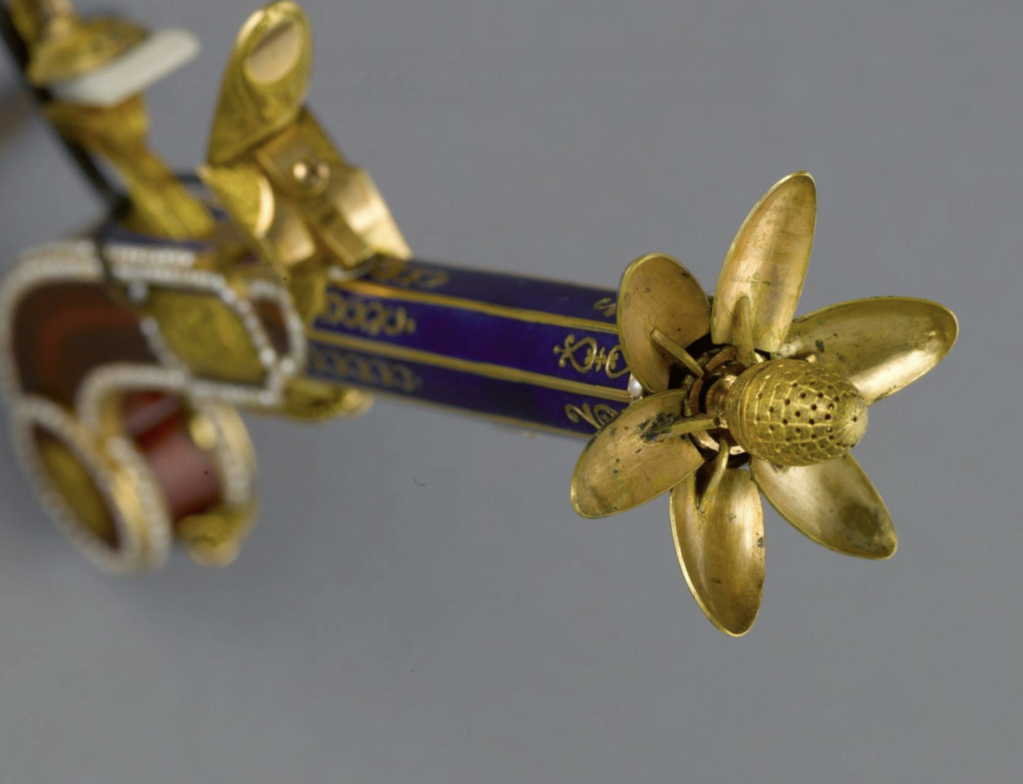
Photos : Musée Cognacq-Jay
 Son frère jumeau sera prochainement proposé en vente aux enchères !
Son frère jumeau sera prochainement proposé en vente aux enchères ! 
Le musée, qui demandait dernièrement à ses visiteurs et amis de l'aider à supporter les coûts de restauration d'un simple Buste de Marie-Antoinette sur piédestal dynastique, serait bien en peine de faire la paire.

Estimé entre 230 000 et 290 000 euros (oui, oui ), je cite :
), je cite :
- A gold, enamel and split pearl automaton pistol perfume spray and timepiece,
Moulinié, Bautte & Ce.,
Geneva, 1804-1808
in the form of a flintlock pistol, the butt enamelled in translucent scarlet over scale engine-turning and concealing the watch movement, the cylinder movement with plain tri-spoke brass balance and feather-tooled escapement fork, the dial with black Breguet numerals on a white enamel ground, the plates chased on one side with a hare and on the other a hound, within narrow black enamel cut-cornered rectangular borders, the faceted barrel enamelled in blue with gold paillon scroll ornament and revealing a cone-shaped rose with six gold and white enamel petals spraying perfume when the chased gold trigger and rectangular quartz hammer, crowned by a gold mask, are struck, all contained within split pearl borders, on gold chains with ring, signed under the trigger: Moulinié Bautte / & Ce
11 cm., 4 1/4 in. long closed; 12.5 cm., 4 7/8 in. open
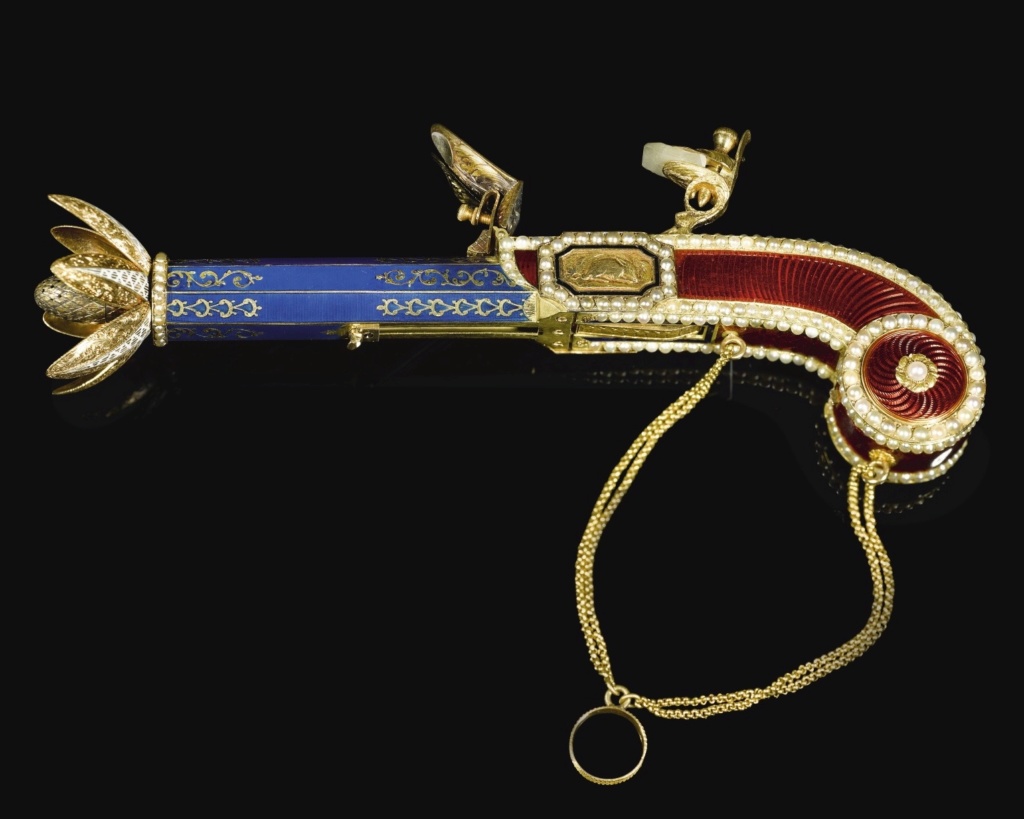
Photo : Sotheby's
Catalogue Note
Moulinié, Bautte & Cie.
By far the most famous Geneva bijoutier horloger of the first half of the 19th century was Jean-François Bautte (1772-1837) whose reputation spread far and wide.
Jean-François was the son of Abraham Bautte, an enameller, and his wife Marie-Anne Mare, but was orphaned in early childhood.
On 19 May 1789, he was formally apprenticed to Moulinié & Blanchot, watchcase makers, both of whom had been received as masters the previous year.
Jean-François is said to have been apprenticed at the age of 12 so possibly a first master had died; part of the Bautte myth states that he was able to turn his hand to all branches of the trade.
Jacques-Dauphin Moulinié (1761-1838) and Jean-François Bautte registered a company together in 1796, stating that it had been in existence since 1 August 1793 with a 9 year contract. On 1 October 1804, a new company, Moulinié, Bautte & Cie., was created for four years with the addition of Jean-Gabriel Moynier (1772-1840) and it was at this time that the present singing bird box was made.
The new firm was registered not just as watchcase makers but more generally 'pour la commerce d'horlogerie et bijouterie'.
From 1808 until 1821 when Moulinié retired, the firm was known as Moulinié, Bautte & Moynier, subsequently as Bautte & Moynier until 1826. The business continued as J.F. Bautte & Cie., even after Jean-François's death in 1837, by his son Jacques and son-in-law Jean Samuel Rossel, until 1855. The company had grown rapidly in size and importance with Bautte’s impetus, employing 60 in-house and 30 outside workers by 1810.
Many are the stories told about this shrewd and charismatic character, apparently known to his workmen as the ‘bourru bienfaisant’, the ‘generous grump’, who, after the Napoleonic wars ended in 1815, became himself a tourist attraction.
His elegant establishment was concealed up a discreet staircase (perfumed with eau de cologne) so that each visitor felt he was making a new discovery. Before this, Bautte's success came from energetic trade abroad, with China and the Middle East and also in Italy and Paris, where Bautte had first entered a goldsmith’s mark in 1808.
The Pistol
For the Near and Far Eastern markets, fresh novelties were always needed and it appears that these pistols were an instant success. Originally made in pairs, they were directly copied from the most up-to-date pairs of Parisian duelling pistols.

A cased pair of double-barreled turn-off flintlock pistols
Jean Lepage, circa 1800
Photo : The MET, New York
The successful idea of a pistol automaton was later taken up by the Frères Rochat who introduced a singing bird which emerged from the barrel rather than a scent spray.
Examples of pairs of both types of imitation pistol were exhibited at Patek Philippe’s loan exhibition of pairs made for the Chinese market, see Arnaud Tellier, The Mirror of Seduction, exhibition catalogue, Patek Philippe Museum, Geneva, 2012, pp. 72-75 and 78-79.
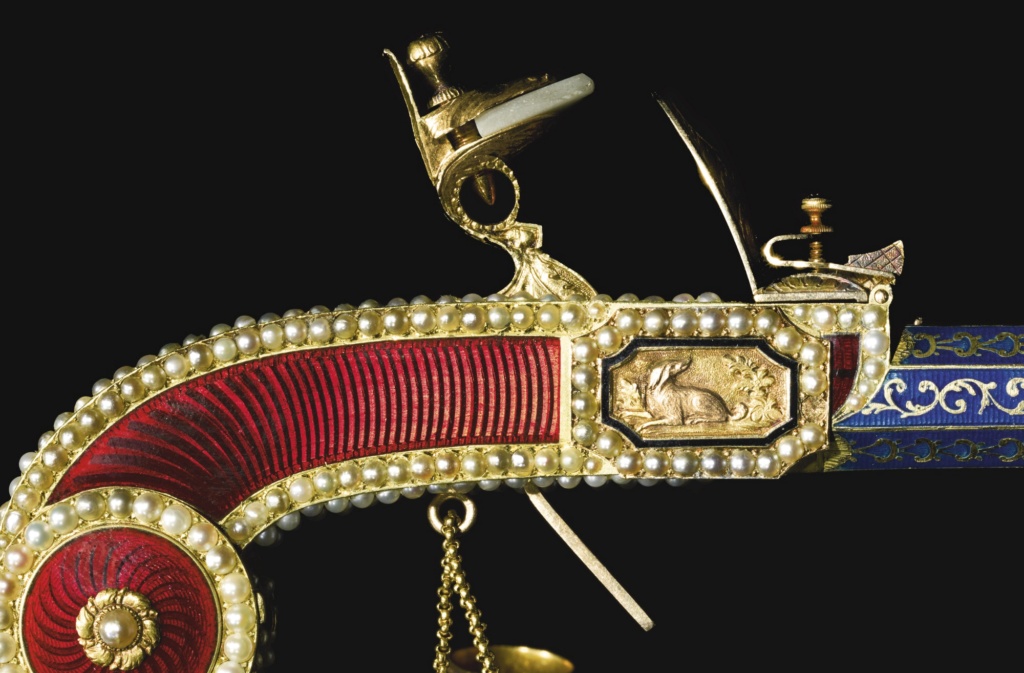

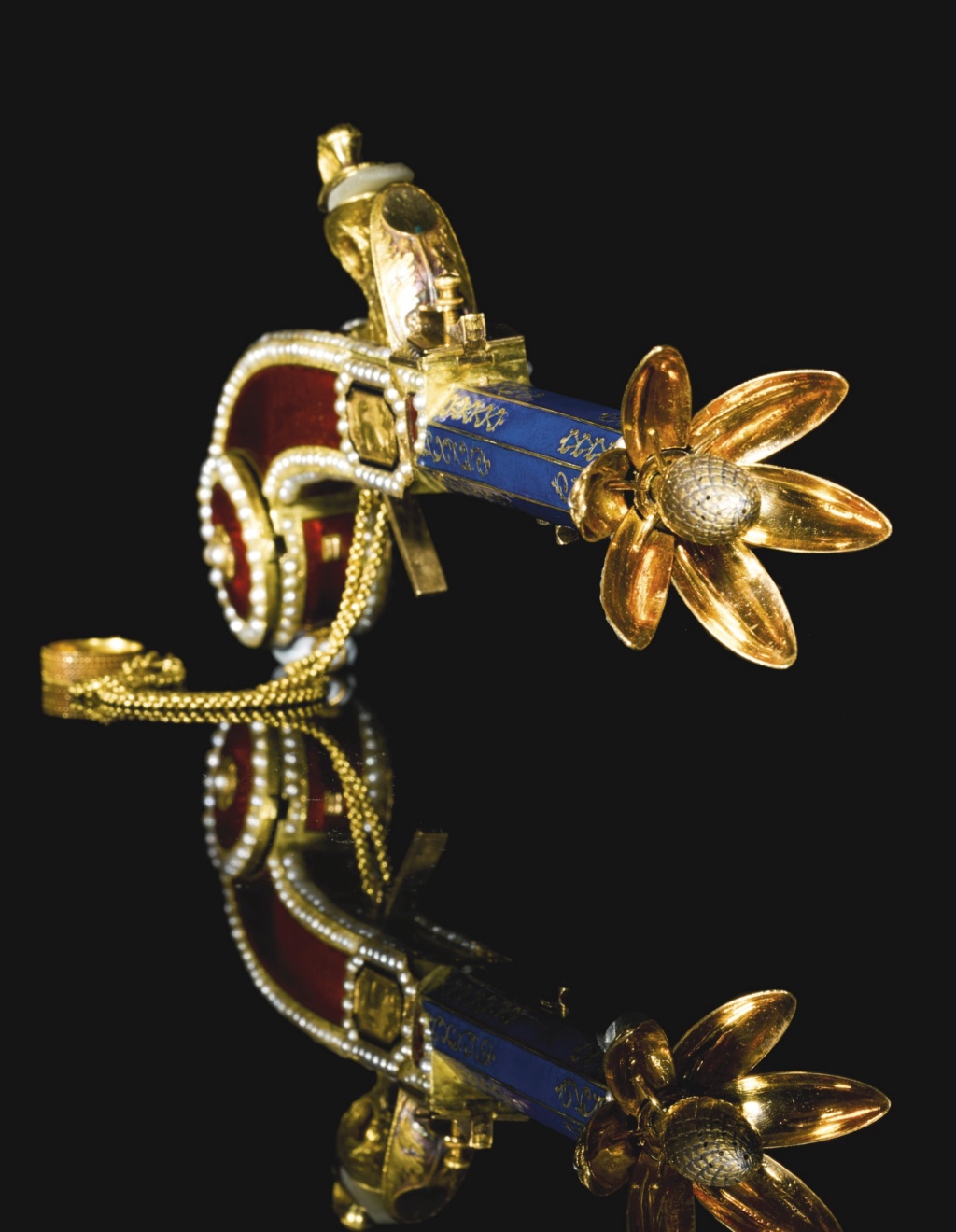
Photos : Sotheby's
Of the surviving examples of scent spray pistols (around fifteen only are recorded, decorated in the same enamel colours but with a variety of chased sporting animals on the side panels), five are signed by Moulinié, Bautte & Cie.:
the present example; the Patek Philippe pair mentioned above; one illustrated in Sturm & Patrizzi, Montres de Fantaisie, Geneva, 1979, no. 26 and cover, with Roman numerals on the dial; and one sold, Sotheby’s Geneva, 6 May 1981, lot 297.
This last was probably originally the pair to the present example since the hare and hound on the side panels appear in reverse, the dials both have arabic numerals, the chains and ring match and neither have red enamel on the borders of the flower petals.
Another example in the Sandoz collection is signed by the marchand-bijoutier Jean-Baptiste Garrand, see Ian White, The Majesty of the Chinese-Market Watch, AHS, London, 2019, ch. 6, no. 20.
Unsigned pistols are to be found in the Wilsdorf Collection, Geneva; Sir David Salomons Collection, Mayer Museum, Jerusalem; the Musée International d’Horlogerie, La Chaux-de-Fonds; and the Topkapi Museum, Istanbul (the dial with Turkish numerals) and in private collections.
* Source et infos complémentaires : Sotheby's London - Sale Treasures, 3 July 2019

Image : Musée Cognacq-Jay, Paris

Pistolet à parfum, vaporisateur de toilette
Jean-François Bautte (1772 - 1837), orfèvre
Genève, vers 1800
Photo : Musée Cognacq-Jay
Description :
Vaporisateur à parfum en forme de pistolet. Le mécanisme d'un pistolet a été miniaturisé pour faire surgir la pomme du vaporisateur.
Le poussoir situé sous le canon du pistolet actionne le vaporisateur, qui s'avance en découvrant un bouton de fleur, lequel s'ouvre pour laisser passer le parfum à travers la pomme du vaporisateur.
Le petit réceptacle de la crosse, aujourd'hui vide, protégeait une montre minuscule.



Photos : Musée Cognacq-Jay
Le musée, qui demandait dernièrement à ses visiteurs et amis de l'aider à supporter les coûts de restauration d'un simple Buste de Marie-Antoinette sur piédestal dynastique, serait bien en peine de faire la paire.


Estimé entre 230 000 et 290 000 euros (oui, oui
 ), je cite :
), je cite : - A gold, enamel and split pearl automaton pistol perfume spray and timepiece,
Moulinié, Bautte & Ce.,
Geneva, 1804-1808
in the form of a flintlock pistol, the butt enamelled in translucent scarlet over scale engine-turning and concealing the watch movement, the cylinder movement with plain tri-spoke brass balance and feather-tooled escapement fork, the dial with black Breguet numerals on a white enamel ground, the plates chased on one side with a hare and on the other a hound, within narrow black enamel cut-cornered rectangular borders, the faceted barrel enamelled in blue with gold paillon scroll ornament and revealing a cone-shaped rose with six gold and white enamel petals spraying perfume when the chased gold trigger and rectangular quartz hammer, crowned by a gold mask, are struck, all contained within split pearl borders, on gold chains with ring, signed under the trigger: Moulinié Bautte / & Ce
11 cm., 4 1/4 in. long closed; 12.5 cm., 4 7/8 in. open

Photo : Sotheby's
Catalogue Note
Moulinié, Bautte & Cie.
By far the most famous Geneva bijoutier horloger of the first half of the 19th century was Jean-François Bautte (1772-1837) whose reputation spread far and wide.
Jean-François was the son of Abraham Bautte, an enameller, and his wife Marie-Anne Mare, but was orphaned in early childhood.
On 19 May 1789, he was formally apprenticed to Moulinié & Blanchot, watchcase makers, both of whom had been received as masters the previous year.
Jean-François is said to have been apprenticed at the age of 12 so possibly a first master had died; part of the Bautte myth states that he was able to turn his hand to all branches of the trade.
Jacques-Dauphin Moulinié (1761-1838) and Jean-François Bautte registered a company together in 1796, stating that it had been in existence since 1 August 1793 with a 9 year contract. On 1 October 1804, a new company, Moulinié, Bautte & Cie., was created for four years with the addition of Jean-Gabriel Moynier (1772-1840) and it was at this time that the present singing bird box was made.
The new firm was registered not just as watchcase makers but more generally 'pour la commerce d'horlogerie et bijouterie'.
From 1808 until 1821 when Moulinié retired, the firm was known as Moulinié, Bautte & Moynier, subsequently as Bautte & Moynier until 1826. The business continued as J.F. Bautte & Cie., even after Jean-François's death in 1837, by his son Jacques and son-in-law Jean Samuel Rossel, until 1855. The company had grown rapidly in size and importance with Bautte’s impetus, employing 60 in-house and 30 outside workers by 1810.
Many are the stories told about this shrewd and charismatic character, apparently known to his workmen as the ‘bourru bienfaisant’, the ‘generous grump’, who, after the Napoleonic wars ended in 1815, became himself a tourist attraction.
His elegant establishment was concealed up a discreet staircase (perfumed with eau de cologne) so that each visitor felt he was making a new discovery. Before this, Bautte's success came from energetic trade abroad, with China and the Middle East and also in Italy and Paris, where Bautte had first entered a goldsmith’s mark in 1808.
The Pistol
For the Near and Far Eastern markets, fresh novelties were always needed and it appears that these pistols were an instant success. Originally made in pairs, they were directly copied from the most up-to-date pairs of Parisian duelling pistols.

A cased pair of double-barreled turn-off flintlock pistols
Jean Lepage, circa 1800
Photo : The MET, New York
The successful idea of a pistol automaton was later taken up by the Frères Rochat who introduced a singing bird which emerged from the barrel rather than a scent spray.
Examples of pairs of both types of imitation pistol were exhibited at Patek Philippe’s loan exhibition of pairs made for the Chinese market, see Arnaud Tellier, The Mirror of Seduction, exhibition catalogue, Patek Philippe Museum, Geneva, 2012, pp. 72-75 and 78-79.



Photos : Sotheby's
Of the surviving examples of scent spray pistols (around fifteen only are recorded, decorated in the same enamel colours but with a variety of chased sporting animals on the side panels), five are signed by Moulinié, Bautte & Cie.:
the present example; the Patek Philippe pair mentioned above; one illustrated in Sturm & Patrizzi, Montres de Fantaisie, Geneva, 1979, no. 26 and cover, with Roman numerals on the dial; and one sold, Sotheby’s Geneva, 6 May 1981, lot 297.
This last was probably originally the pair to the present example since the hare and hound on the side panels appear in reverse, the dials both have arabic numerals, the chains and ring match and neither have red enamel on the borders of the flower petals.
Another example in the Sandoz collection is signed by the marchand-bijoutier Jean-Baptiste Garrand, see Ian White, The Majesty of the Chinese-Market Watch, AHS, London, 2019, ch. 6, no. 20.
Unsigned pistols are to be found in the Wilsdorf Collection, Geneva; Sir David Salomons Collection, Mayer Museum, Jerusalem; the Musée International d’Horlogerie, La Chaux-de-Fonds; and the Topkapi Museum, Istanbul (the dial with Turkish numerals) and in private collections.
* Source et infos complémentaires : Sotheby's London - Sale Treasures, 3 July 2019
Dernière édition par La nuit, la neige le Dim 17 Mar 2024, 17:24, édité 6 fois
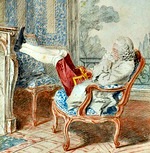
La nuit, la neige- Messages : 17779
Date d'inscription : 21/12/2013
 Objets de vertu (boites, tabatières, montres, étuis et autres objets précieux du XVIIIe siècle
Objets de vertu (boites, tabatières, montres, étuis et autres objets précieux du XVIIIe siècle
Oh cette boîte est toute mignonne 





_________________
« elle dominait de la tête toutes les dames de sa cour, comme un grand chêne, dans une forêt, s'élève au-dessus des arbres qui l'environnent. »
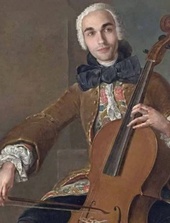
Comte d'Hézècques- Messages : 4362
Date d'inscription : 21/12/2013
Age : 43
Localisation : Pays-Bas autrichiens
 Re: Boites, tabatières, montres, étuis et autres objets précieux du XVIIIe siècle
Re: Boites, tabatières, montres, étuis et autres objets précieux du XVIIIe siècle
Voici donc un autre exemplaire de ces ravissants pistolets-vaporisateurs-montres (voir autres modèles ci-dessus) qui sera prochainement présenté en vente aux enchères :
ATTRIBUTED TO MOULINIÉ, BAUTTE & CIE. OR J.B. GARRAND, GENEVA. AN EXTREMELY RARE, IMPORTANT AND VERY FINE GOLD ENAMEL AND PEARL-SET FLINTLOCK PISTOL-FORM PERFUME SPRINKLER WITH CONCEALED WATCH, MADE FOR THE CHINESE MARKET
SWISS, GENEVA, CIRCA 1805
Movement: Manual, gilt brass, verge escapement, chain fusée, pierced and chased balance cock
Dial: White enamel, concealed behind circular covers at the end of the handle, opening via a concealed button in the band
Case: Flintlock pistol-shaped gold case, grips overlaid with translucent scarlet enamel over engine-turned background, set with pearl-set gold rosette, split pearl-set lower and upper edges, centred by split-pearl framed gold plates finely chased with a hound on one side and a rabbit on the reverse, the top edges set with half pearls, gold matted and engraved hammer, the head of the flint arm engraved with lion's head, engraved rounded gold flint nut, agate flint, blue enamelled octagonal barrel decorated with paillonné and laurel foliage simulating damascene work, pearl-set tip, the perfume is spread through the pistils of the gold tulip with enamel petals, released by the percussion of the hammer when the trigger is depressed, with gold slide underneath to retreat into the barrel, 111 mm. overall length
(...)

Lot Essay (extraits)
A superb and exquisite ‘montre de fantasie’, the present pistol is identical to the example once in the collection of King Farouk of Egypt and is perhaps one and the same piece. A treasured part of one of the world’s great watch collections for the past almost 20 years, the present pistol affords collectors the exceptional opportunity once again to acquire an example of these fascinating and precious creations.
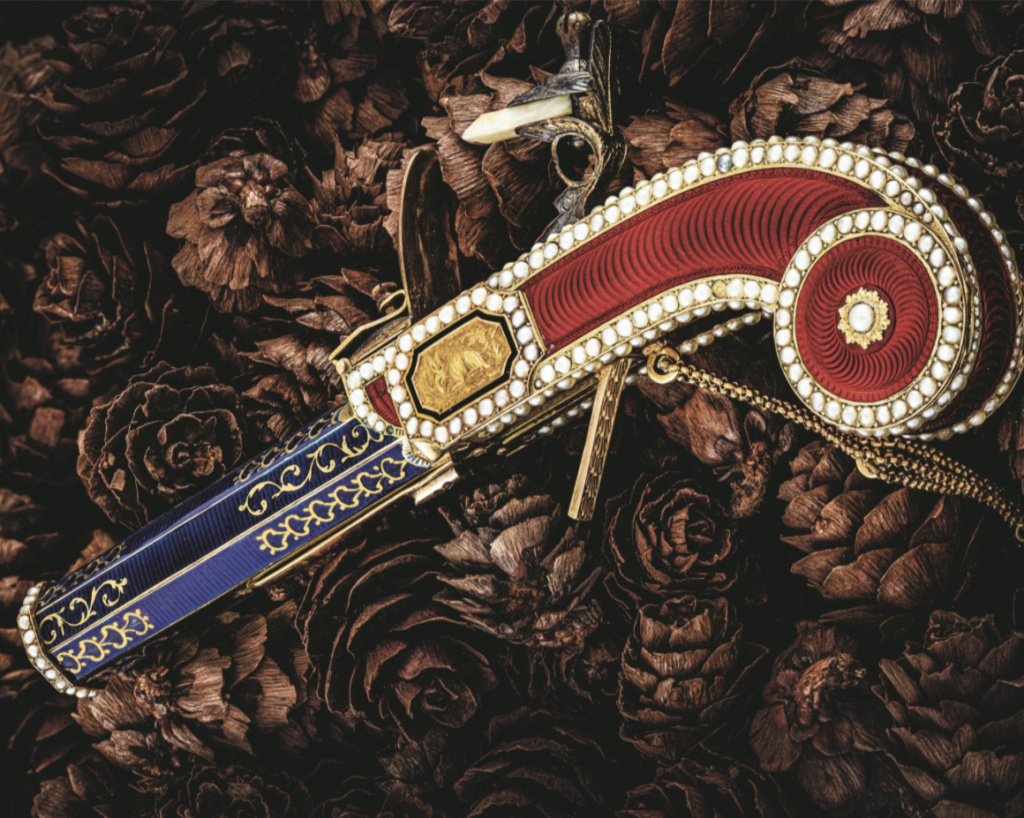
Flintlock pistol form perfume sprinkler watches are amongst the greatest rarities in the realm of automated precious objects, only around 12 examples are known to exist today, gracing some of the most distinguished collections in the world.
Even to the casual observer, pistol perfume sprinkler watches are also perhaps the most memorable and intriguing of the products made in Geneva workshops in the opening years of the 19th century.
With the spectacular combination of sumptuously decorated gold cases and exceedingly intricate movements, the perfume sprinkler pistol watches are the perfect example of the coveted decorative objects made for discerning dignitaries and royalty in China and Europe.
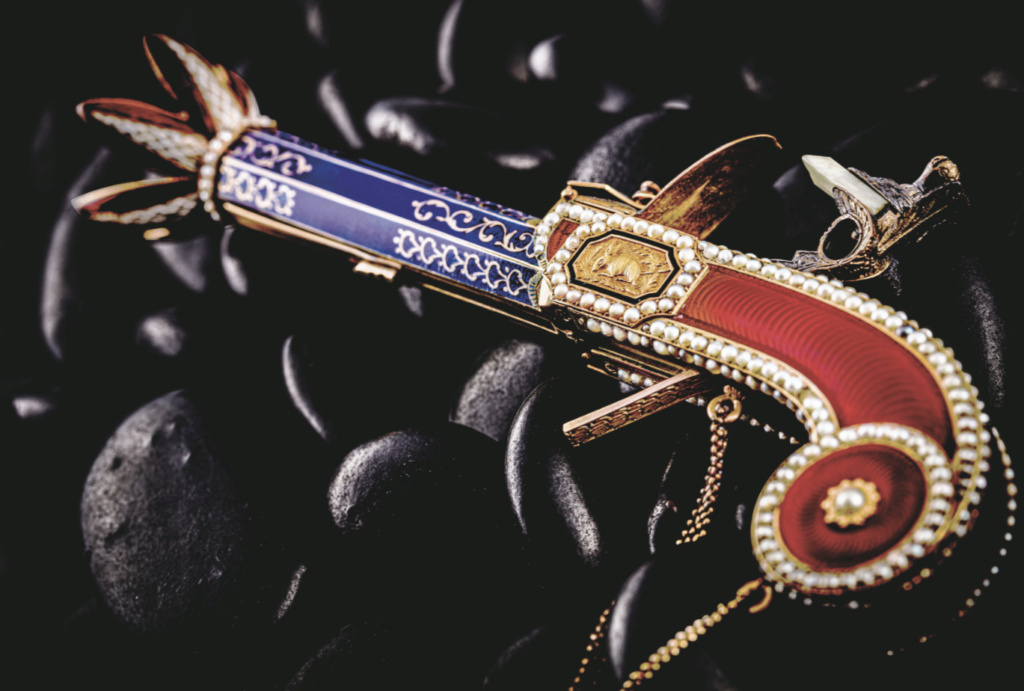

It is fascinating that such exquisite gold pistols were actually directly copied from real weapons of the period. Like duelling pistols, they were originally made in pairs. When the pistol is ‘fired’, a gold and enamel flower bud emerges from the end of the barrel and opens to release a spray of perfume.
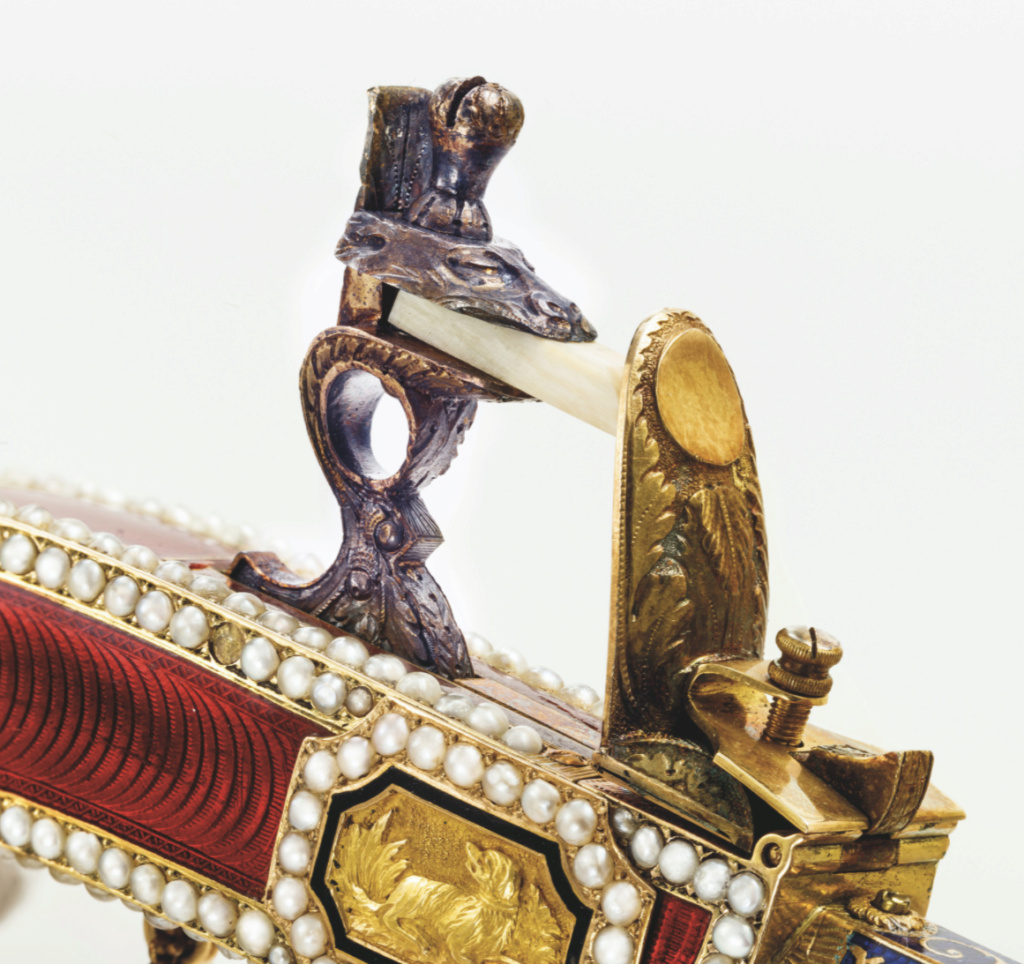

The watch is fitted within the butt and concealed by a hinged cover.

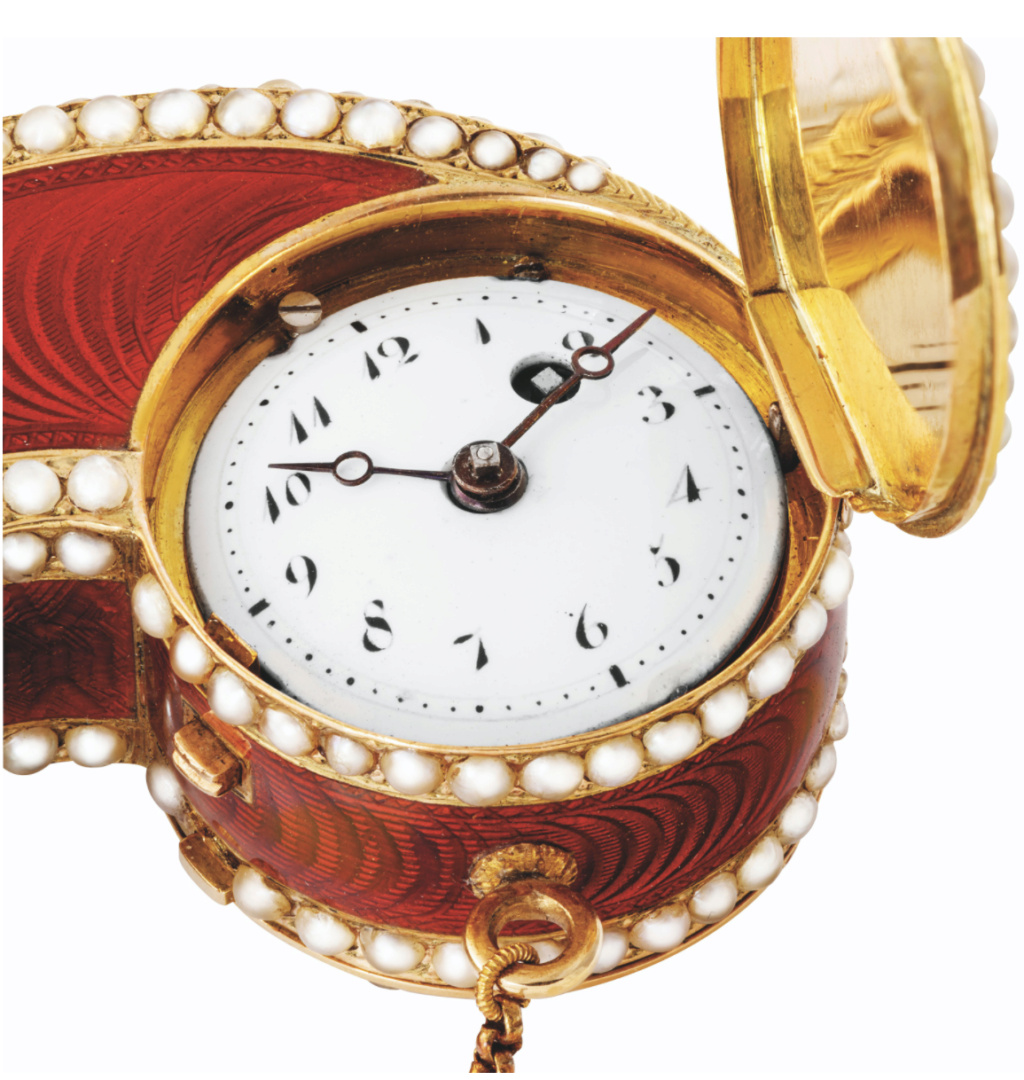

The names of two Geneva firms are associated with the manufacture of the present type of pistol, signed examples exist by both Moulinié, Bautte & Cie. and J.B. Garrand. The present example, although apparently unsigned, can be attributed to Moulinié, Bautte & Cie. or J.B. Garrand on this basis.
Other examples of pistol perfume sprinker watches are in the Patek Philippe Museum, Geneva, the Sandoz Collection; the Wilsdorf Collection, Geneva; the Sir David Salomons Collection, Mayer Museum, Jerusalem; the Musée International d’Horlogerie, La Chaux-de-Fonds; and a Turkish market example is in the Topkapi Museum, Istanbul.
We are grateful to Eric Tortella for his assistance and study in researching this watch.
Moulinié, Bautte & Cie.
The celebrated firm of Moulinié, Bautte & Cie were famed for their fantasy musical and mechanical objects made in gold, enamel, jewels and pearls known at the time as “toys”. The firm supplied their costly treasures to clients in China, India, Spain, Italy, France, England and Austria, in addition to the store in Geneva, they had branches in Paris and Florence.
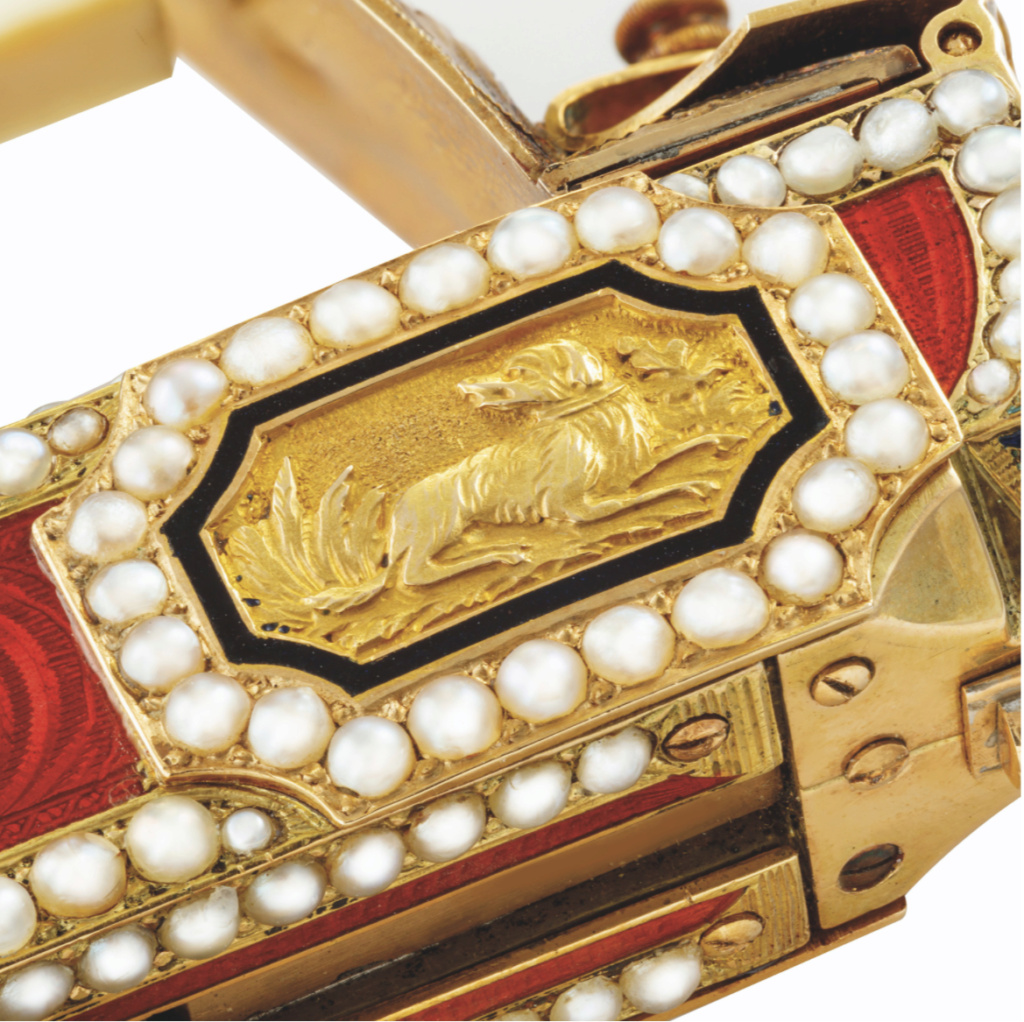

On August 1st, 1793, Jean-François Bautte had joined forces with Jacques-Dauphin Moulinié, the case-maker established in Geneva since 1791, thus forming ‘Moulinié & Bautte, monteurs de boîtes’. On October 1st, 1804, Jean-Gabriel Moynier (1772-1840), a watchmaker from Geneva, joined them and the workshop was renamed ‘Moulinié, Bautte & Cie, fabrique d’horlogerie’.
The company only traded under the name of Moulinié, Bautte & Cie for four years from 1st October 1804, therefore the present pistol can be dated quite accurately to within the four-year period 1804-1808.
In 1808, the association became Moulinié, Bautte & Moynier, fabrique d’horlogerie. This was a very successful period for Jean-François Bautte, who became the most important watch dealer in Geneva. Around 1810, this factory produced watches and luxury jewellery and had more than 60 workers in the workshop and 30 at home.
Around 1824, following the departure of Jacques-Dauphin Moulinié, the manufacture remained in the hands of Jean-François Bautte and Jean-Gabriel Moynier under the new name of Bautte & Moynier, at 61, rue du Rhône.
In 1828, the company presented at the Geneva Exhibition the twelve demonstration models of escapements made by Antoine Tavan (1749-1836) for the Melly brothers (active between 1790 and 1829) around 1800-1805. In 1828, a Moulinié Aîné & Cie, fabricants d’horlogerie, located in rue de la Cité, was present at the Geneva Exhibition; this company was still in business in 1851.

Jean Baptiste Garrand
Born in 1768, he came to Geneva around 1797. He was witness to the wedding of the enamel painter Jean François Soiron. Garrand entered a maker’s mark JB over G in a lozenge in 1807 and again in 1815 with premises in Rue Cendrier. Garrand père et fils is recorded at the same address in 1828. He died in February 1838.
An example of a pistol form perfume sprinkler watch signed ‘Garrand’ is in the collection of the Fondation Edouard & Maurice Sandoz, Pully, Switzerland. A gold and enamel book-form vinaigrette by J. B. Garrand was sold: Bonham’s London, 21 November 2012, lot 2.
(...)

ATTRIBUTED TO PIGUET ET MEYLAN. AN EXTREMELY FINE AND VERY RARE 18K GOLD AND ENAMEL MUSICAL BOX WITH AUTOMATON AND CENTER-SECONDS WATCH, MADE FOR THE CHINESE MARKET
SWISS, GENEVA, NO. 1447
THE BOX ATTRIBUTED TO RÉMOND, LAMY, MERCIER & CO
CIRCA 1815
Movement: Manual, rectangular brass plates, bridge caliber, fixed barrel, cylinder escapement, fourth wheel in the centre for the centre seconds, disc musical movement set on the same plate with 21 tuned teeth engaging pins on both sides of the disc, automata driven from a wheel-cam set on the protruding arbour of the pinned disc, numbered 1447
Dial: White enamel set in the middle of the automaton scene, to the right, a varicloured gold and silver figure of a lady playing the harp, to the left a gentleman playing a lute, finely painted enamel on gold scene, the background of a room with columns, two tables, musical instruments and a window with a view of a classical palace, apertures for winding the watch, automaton, setting and regulating, numbered 1447
Case: Three-body, all panels overlaid with translucent dark blue guilloche enamel, black lattice, the edges in light green opaque champlevé enamel with gold floral pattern, hinged top and bottom, the top with aperture to view the watch dial, the border set with half-pearls, the back with small compartment, 82 mm. wide, 44 mm. deep, 17 mm high
With: Original gold and enamel key.
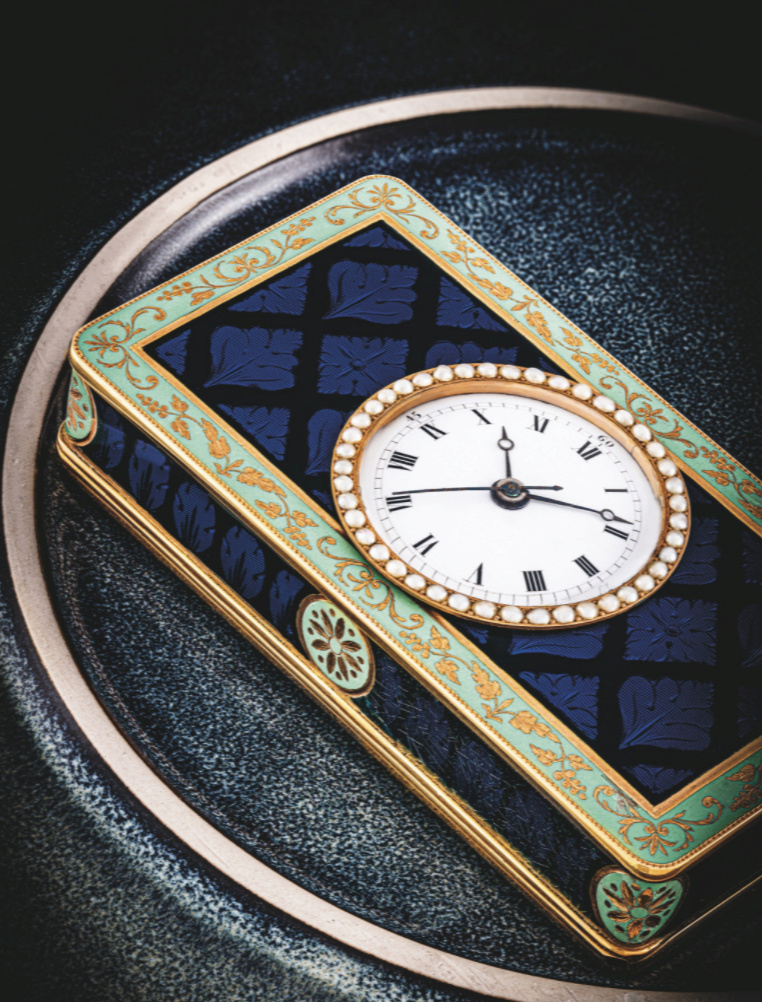

Lot Essay (extraits)
Since its purchase by the present owner, this exquisite and extremely rare musical and automaton box, has remained in the same private collection for nearly two decades. It can be attributed to the famous firm of Piguet et Meylan of Geneva.
An identical box, also unsigned, was in the collection of Sir David Lionel Salomons. It is illustrated in: ‘Le Monde des Automates’ Chapuis and Gélis, fig. 308, where it is attributed to Piguet et Meylan. A further similar example was in the collection of King Farouk of Egypt.

Featuring the same composition of a lady playing a harp on the right and a gentleman accompanying her on the guitar, the painted enamel background is also set in a room and the musical instruments had strikingly similar details. This box was punched with the mark of Piguet et Meylan. Another related box was sold by Christie’s Geneva, 16th May 2001, lot 200.

The fine gold and enamel box can be attributed to one of the best goldsmiths of the period, Jean-Georges Rémond, probably dating from the period when the company was called Rémond, Lamy, Mercier & Co., between 1811 and 1819. The combination of the distinctive black latticework under the translucent enamel and engraving on engine turning forming floral or foliate patterns, and sometimes geometrical designs, is very characteristic of his work. Indeed, Rémond was probably the first to apply a black painted geometric pattern beneath translucent enamel, usually a rich dark blue, which enhanced the appearance of the pieces considerably.


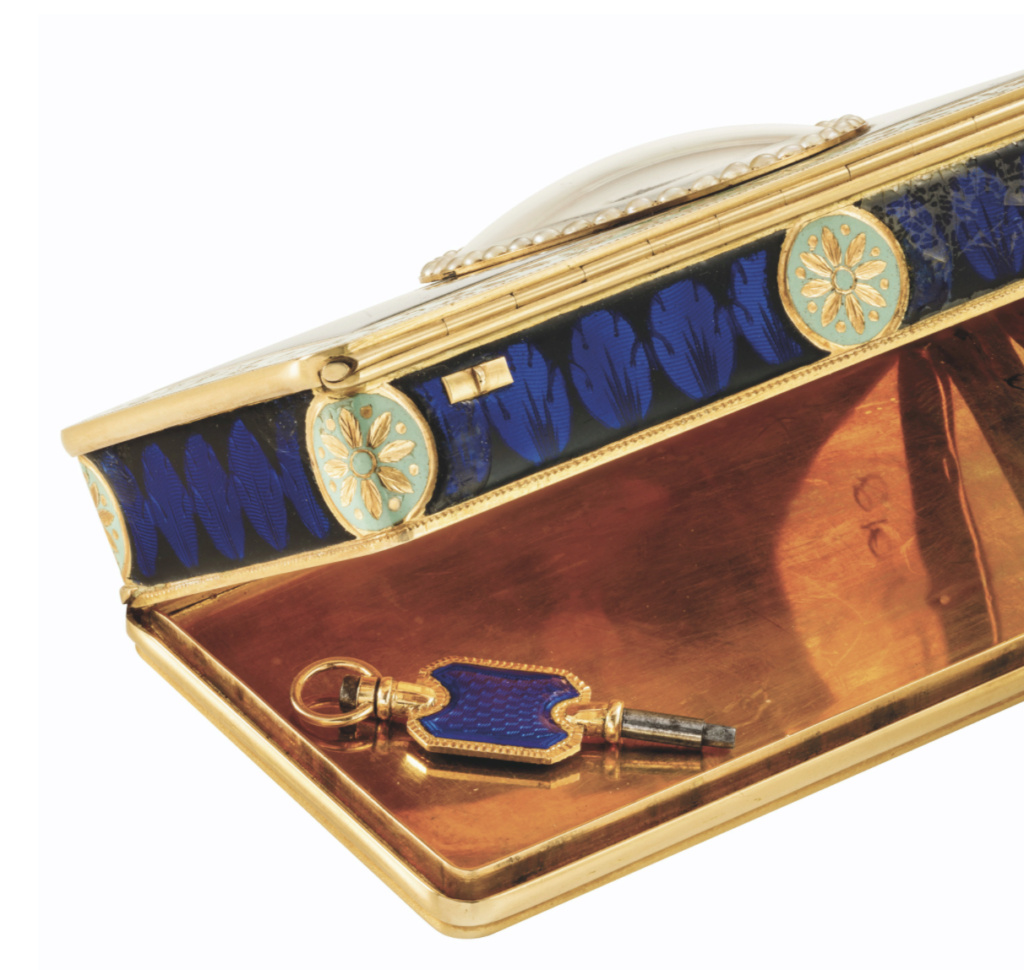
Jean-Georges Rémond was one of the most eminent horological goldsmiths of all time, although best known for snuff boxes he produced a variety of precious objects. Rémond had become a master goldsmith in 1783, at various stages of his career he formed companies with several other goldsmiths, often the associations did not last more than a few years and the companies were dissolved and renamed as partners came and left.
In 1804 Rémond formed a new company in Geneva, Jean-Georges Rémond et Compagnie, the company is recorded as “pour exercer le commerce de bijouterie et horlogerie”. When the company was dissolved in 1811, Rémond immediately established a new company – Rémond, Lamy, Mercier & Co., with an impressive capital of 400,000 Francs. The company produced a variety of magnificent objets de vertu, from small etuis to highly elaborate gold and enamel boxes, singing birds and cases for repeating watches.
Piguet & Meylan
Isaac-Daniel Piguet was born in Le Chenit in the Valley of Joux in 1775. At an early age, he specialized in the manufacturing of expensive and complicated pieces such as watches with carillons and en passant hour and quarter striking clock watches. He finally settled in Geneva where, in 1811, he formed a partnership with Philippe-Samuel Meylan.
Philippe-Samuel Meylan (1772-1845), a member of a family of renowned watchmakers, was born in Le Brassus. He specialized in the production of very thin watches and became an eminent maker of watches with musical automata.
(...)
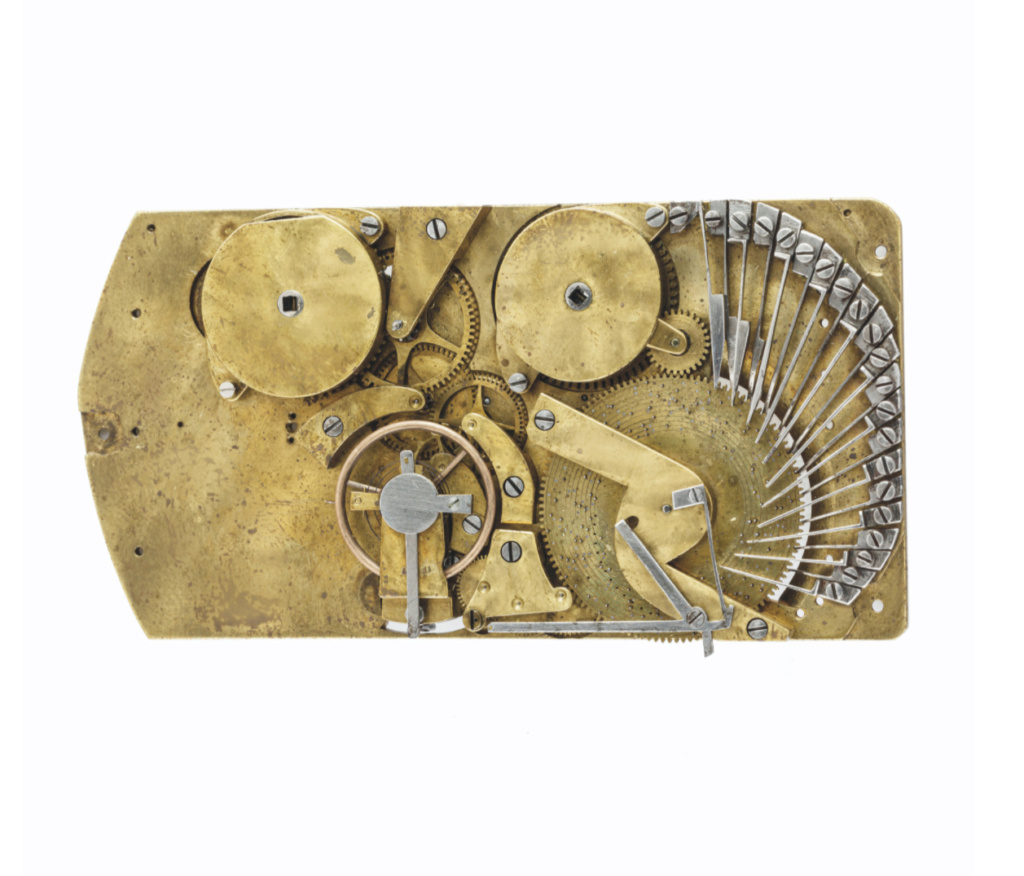
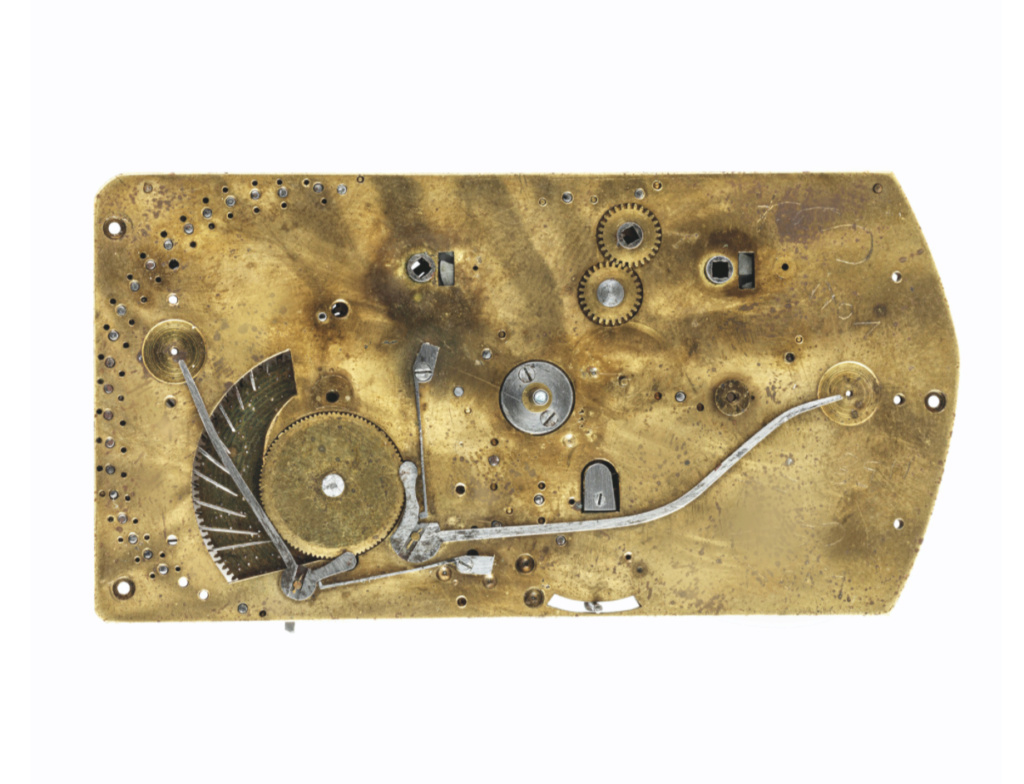
ATTRIBUTED TO PIGUET & CAPT. A HIGHLY IMPORTANT AND MAGNIFICENT 18K GOLD AND ENAMEL, PEARL-SET MUSICAL, PERFUME FLASK AND AUTOMATON AMPHORA-FORM WATCH MADE FOR THE CHINESE MARKET
SWISS, THE ENAMEL ATTRIBUTED TO JEAN-FRANCOIS-ADAM HESS,
CIRCA 1805
Movement: Manual, oval full plate, fixed barrel, cylinder escapement, steel escapement wheel, silver four-arm balance. Music and automaton with five-wheel train, small two-wing fly governor, pinned barrel with six stacked tuned teeth, automaton animated by two cams driven by the musical train
Dial: White enamel, Breguet numerals within an oval blue enamelled plate with aperture for the visible polished steel diamond-set balance, white enamel subsidiary seconds above
Case: Painted enamel panel below the watch decorated with a scene of a mother and her child holding grapes, opening to reveal the varicoloured gold automaton scene which depicts a boy to the left raising and lowering a stick, trying to encourage a dog to jump over it, to the right, a young lady plays a guitar, finely painted background with a classical urn upon a plinth within a wooded landscape, the body of the case richly set with graduated pearls and inlaid with polychrome champlevé enamel, sides with foliate engraving, set with pearls and polychrome champlevé enamel, the handles set with graduated pearls, the oval painted enamel panel over the watch movement decorated with a pair of nesting doves within a garland of flowers, panel below decorated with a finely painted pastoral scene of a herdsman driving his cattle to water beside a bridge, a village and castle beyond, 102 mm. high, 58 mm. wide



Lot Essay (extraits)
Made in Geneva for the Chinese export market, this extraordinarily beautiful and precious ‘montre de fantasie’ with music and automaton is regarded as one of the great mechanical and artistic masterpieces to have been made in early 19th century Geneva.
A wondrous object, it still possesses the power to enchant more than 200 years after it was made, a superb jewel and mechanical marvel that would make a world-class addition to even the most exalted collection.

Originally one half of a mirror image pair of amphoras, its long-separated twin had for many years resided in one of the world’s best collections of watches, owned by Lord Sandberg CBE (1927-2017), former chairman of the Hong Kong and Shanghai Bank. His collection was sold in a landmark auction in Geneva in 2001.
At the auction, the mirror image pair to the present amphora was acquired by the Patek Philippe Museum in Geneva where it is now displayed along with other exceptional enamels, automata and watches in the museum’s matchless collection.
Remarkably, the present amphora had remained completely unknown and presumed lost. In fact, it had been in the ownership of a private Japanese family in whose possession it had been for generations. Its rediscovery in 2001 was as a direct result of the then owner recognizing Lord Sandberg’s amphora as its long lost mirror image pair. When the family sold the present amphora in 2002, it realized over 4 million Swiss Francs – a world record for any enamelled watch.
It had long been a tradition to send objects to China in pairs, According to Alfred Chapuis, ‘Le Miroir de la Séduction’, Musée Patek Philippe, Geneva, 2010, p. 28, "the Chinese love symmetry; all gifts to a superior, and above all the Emperor, were given in pairs."
It seems certain that many pairs of Chinese Market watches and boxes were split up as a result of looting by the British and French during the raid on the Summer palace in Peking in 1860.
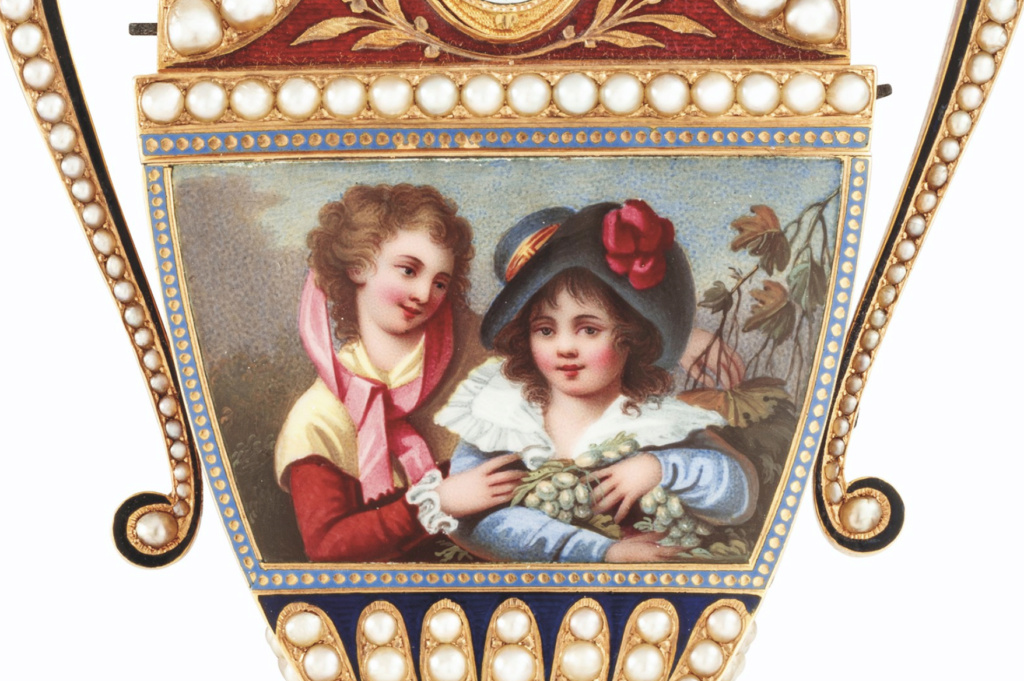
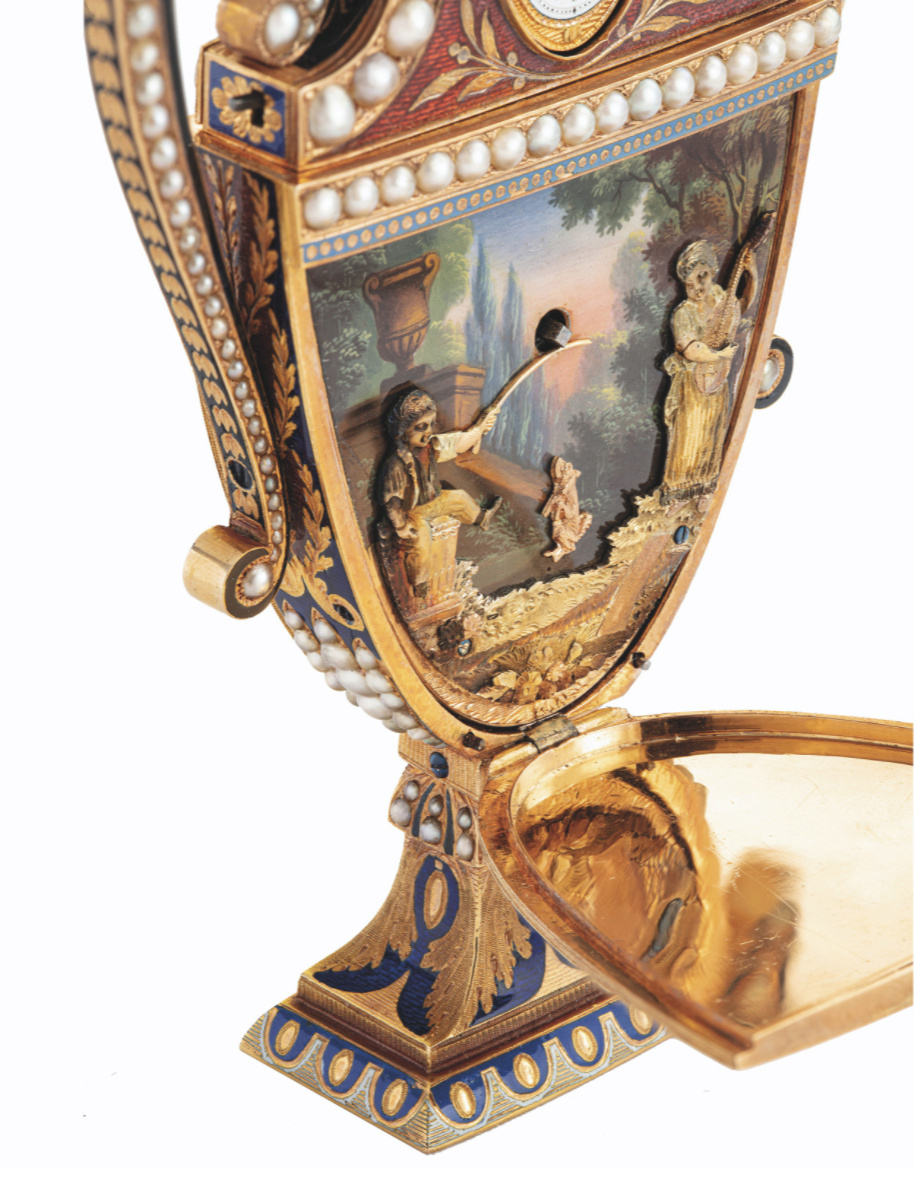
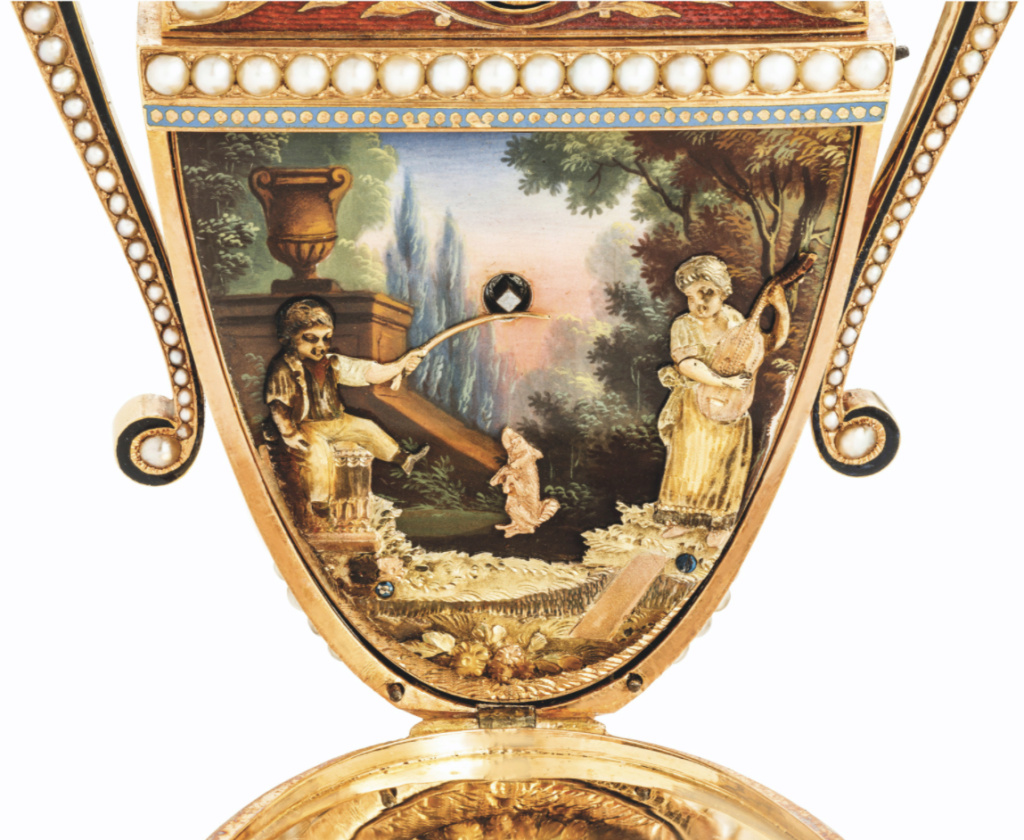
Attributable stylistically to Piguet and Capt, the most important Geneva makers of complicated small automata and watches in the early 19th century, the making of the present musical automaton amphora watch was a feat that required quite exceptional skill to achieve.
Recent in-depth research and study suggest that the Charming painted enamel rural scenes can now be attributed to Jean-François-Adam Hess (1740 ca.-1814).
Very often, watches and precious objects made in Geneva at the beginning of the 19th century are not signed. This was most likely due to customs restrictions and the continental blockade imposed by the British to counteract continental trade under Napoleon’s reign, Geneva having been annexed to France since 1798.
Although signatures or trademarks are sometimes found inside the movements or cases, the enamels often remain anonymous. It is only by comparison with the rare signed pieces that have survived that we can today attribute the achievements of the Geneva enamel painters to a particular workshop.
The enamel paintings of the the two Amphoras (the present example and its pair in the Patek Philippe Museum) have historically been attributed to Jean-Louis Richter (1766-1841), or even to Jean-Abraham Lissignol (1749-1819). However, in comparing the enamel scene of a pocket watch with enamel signed ‘Hess’, acquired by the Patek Philippe Museum in 2005, it is now possible to suggest a new attribution for the amphora enamels to the artist named ‘Hess’.

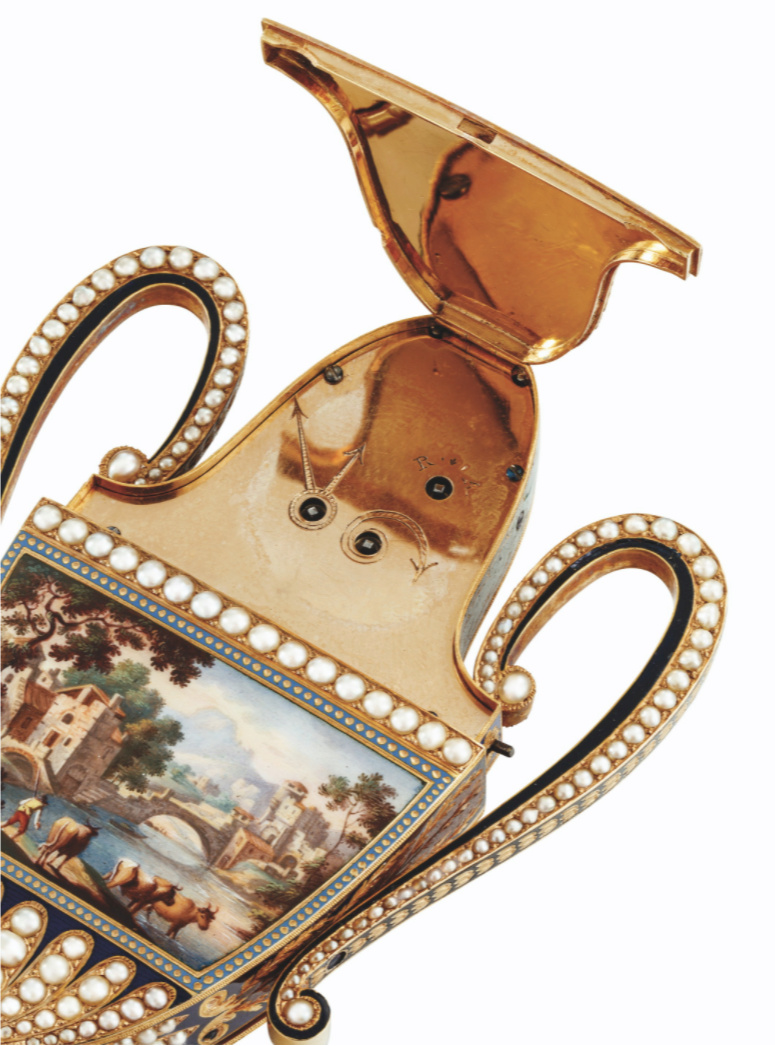
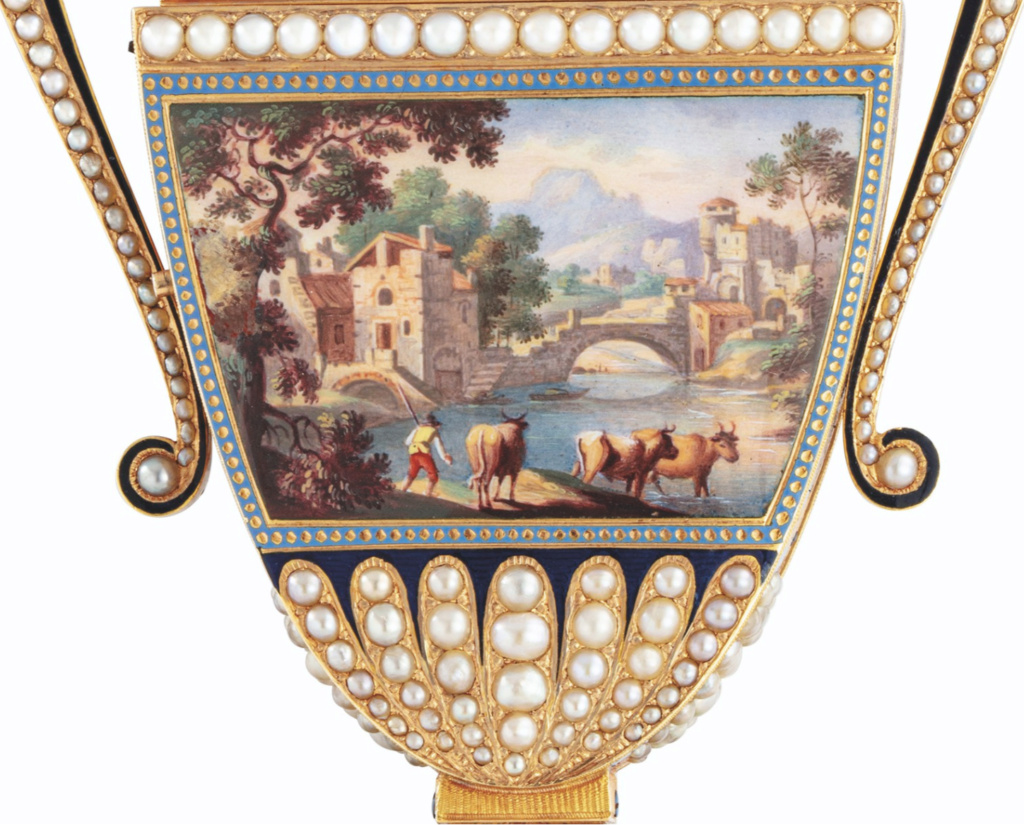
Very little information is known to date about this artist who was active in Geneva in the first half of the 19th century. There are even several enamel painters with this surname, which further complicates any attribution (the last two being naturally too young to have made these enamels):
• Jean-François-Adam Hess (c.1740-1814);
• F.-Léonard Hess (1772-1875);
• François-Jacob (1773-1846);
• Moyse Ludwig Hess (1778-1851);
• Pierre-Marc Hess (1800-1841);
• Jules-Marc Hess (1802-1841).
The scene depicted on the Amphoras – L’Amour maternel (Maternal Love), is perhaps painted after a composition by Elisabeth Vigée-Lebrun (1755-1842), and is seen several times on watches or objects of the same period. However, such idealized images were largely influenced by English genre paintings by artists from the Royal Academy such as Joshua Reynolds, Francis Wheatley, William Hamilton and William Redmore Bigg, who specialized in depictions of romanticized English rural life in the last quarter of the 18th century. Their paintings were engraved and sold as prints which were enormously popular and were used as models for the Genevan enamellers.
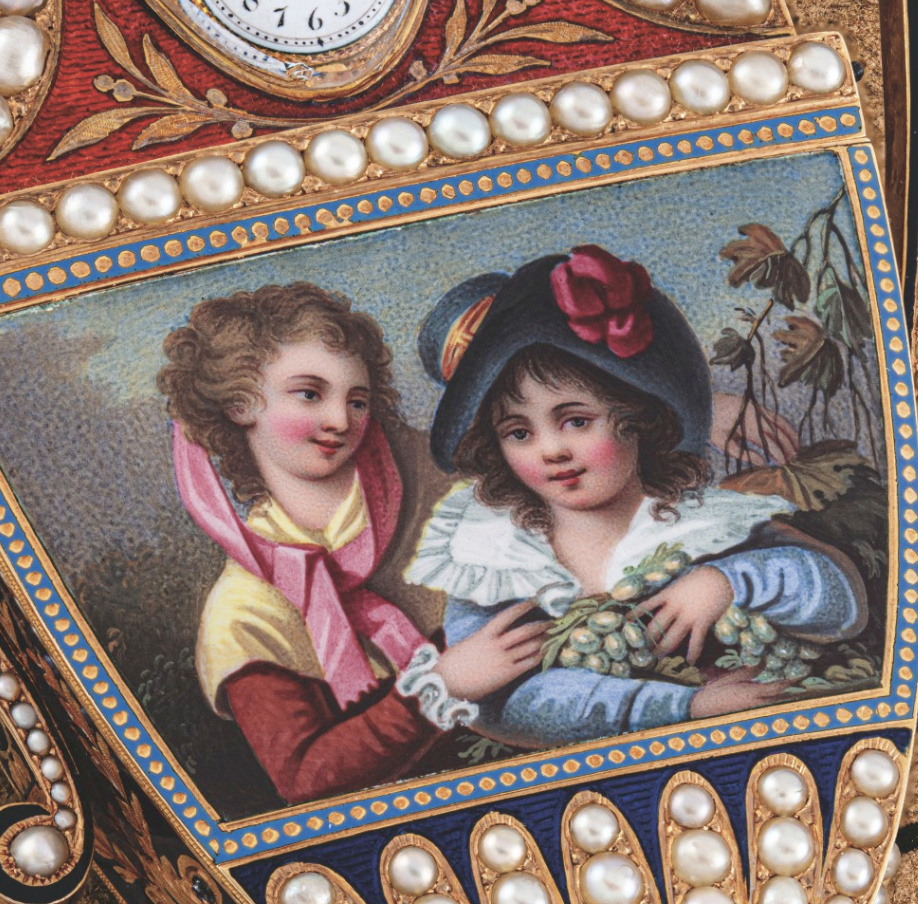
Piguet & Capt (active between 1802 and 1810-1811)
Henry-Daniel Capt (1773-1841) and Isaac-Daniel Piguet (1775-1841), two young watchmakers from Le Chenit, a small village in the Vallée de Joux (Canton of Vaud), came to Geneva to work at the beginning of the 19th century. They joined forces on 16 Ventôse of the year X of the Republic (March 7, 1802), under the name of Piguet & Capt, and specialised in the production of prestige timepieces (watches, snuffboxes, bonbonnières, jewellery, etc.), incorporating horological complications (quarter-repeater), and scenes with automata, with or without music. They were among the first in Geneva to use the musical mechanism with pinned cylinder (or planted pins) and tuned vibrating blades.

This mechanism was invented in 1796 by Antoine Favre-Salomon (1734-1824), a Genevan clockmaker and mechanician, who presented it to the Société des Arts (created in 1776) for use by all.
This new mechanism plays music by making steel blades of different lengths vibrate by means of a cylinder fitted with “goupilles piquées” (pinned pins) or “picots plantés” (planted pimples) according to the expressions of the time. This cylinder is either driven by a gear and motor barrel, or is directly the barrel containing the mainspring. The blades, tuned to the tones of the musical scale, are arranged like a keyboard – hence the early term “musique à peigne” (comb music). In its early days, this original mechanism was incorporated into small precious objects; only later was it put into boxes made of wood or other materials, more or less richly decorated, in an autonomous way.


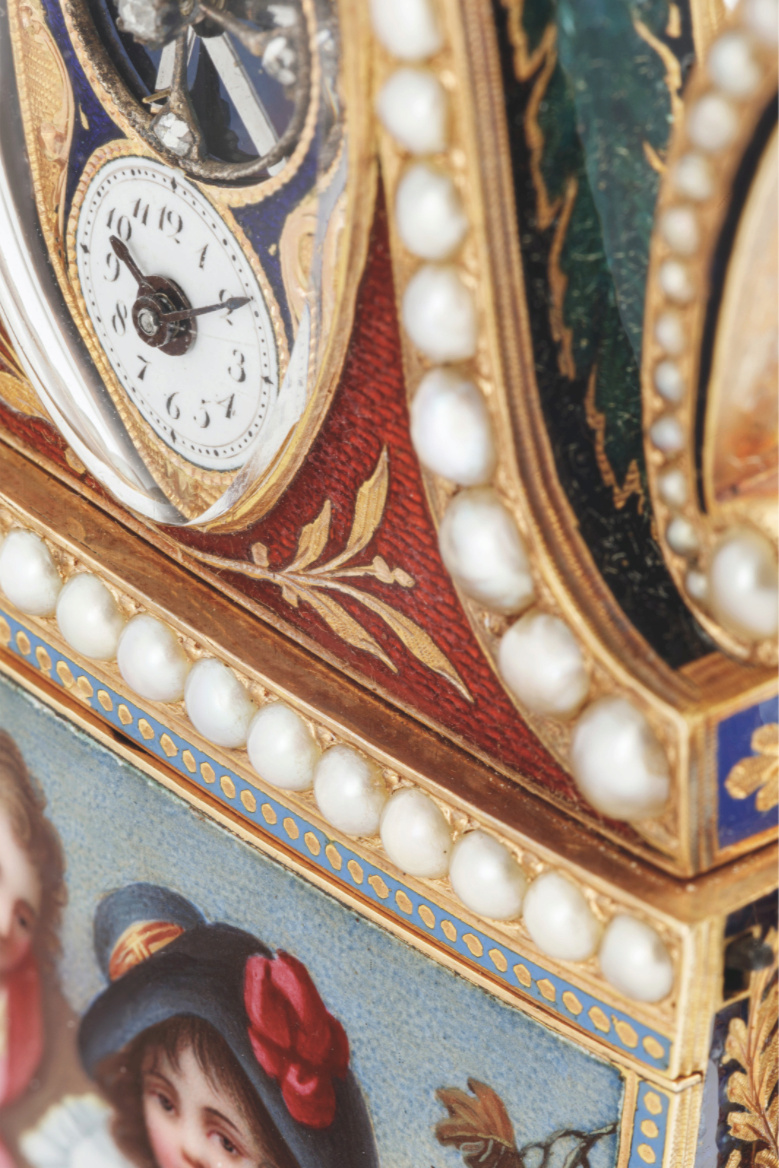
The partnership between Capt and Piguet was dissolved at the end of 1810 or the very beginning of 1811. While Henry-Daniel Capt continued to work alone for a few years, Isaac-Daniel Piguet joined Philippe-Samuel Meylan (1772-1845) in a new partnership.
Henry-Daniel Capt, Isaac-Daniel Piguet and Philippe-Samuel Meylan were the main Genevan manufacturers of miniature automata and music pieces in the first third of the 19th century. Although most of their works are unsigned, they sometimes engraved their names or stamped their trademarks on their movements.
We are grateful to Eric Tortella for his assistance and study in researching this watch.
(...)
* Source et infos complémentaires, et vidéos des mécanismes musicaux en action, ici : Christie's HK - Sale The Legends of Time, 22 May 2021

La nuit, la neige- Messages : 17779
Date d'inscription : 21/12/2013
 Pavillon chinois de l'Hôtel de Montmorency-Luxembourg
Pavillon chinois de l'Hôtel de Montmorency-Luxembourg
Voici un objet étonnant, constitué d'un assemblage de boîtes, qui sera prochainement présenté en vente aux enchères, et l'occasion d'évoquer un site disparu...
Maquette du Pavillon chinois de l'hôtel de Montmorency-Luxembourg
Atelier d'architecture de Pierre ROUSSEAU, Paris - vers 1770/1780
Dimensions : Hauteur totale 850mm - Base 510 x 405 mm
Bel état de conservation général, présence de toutes les boîtes et des personnages habillés. Certaines des bannes (percale et papier) occultant les baies de la folie sont endommagées.

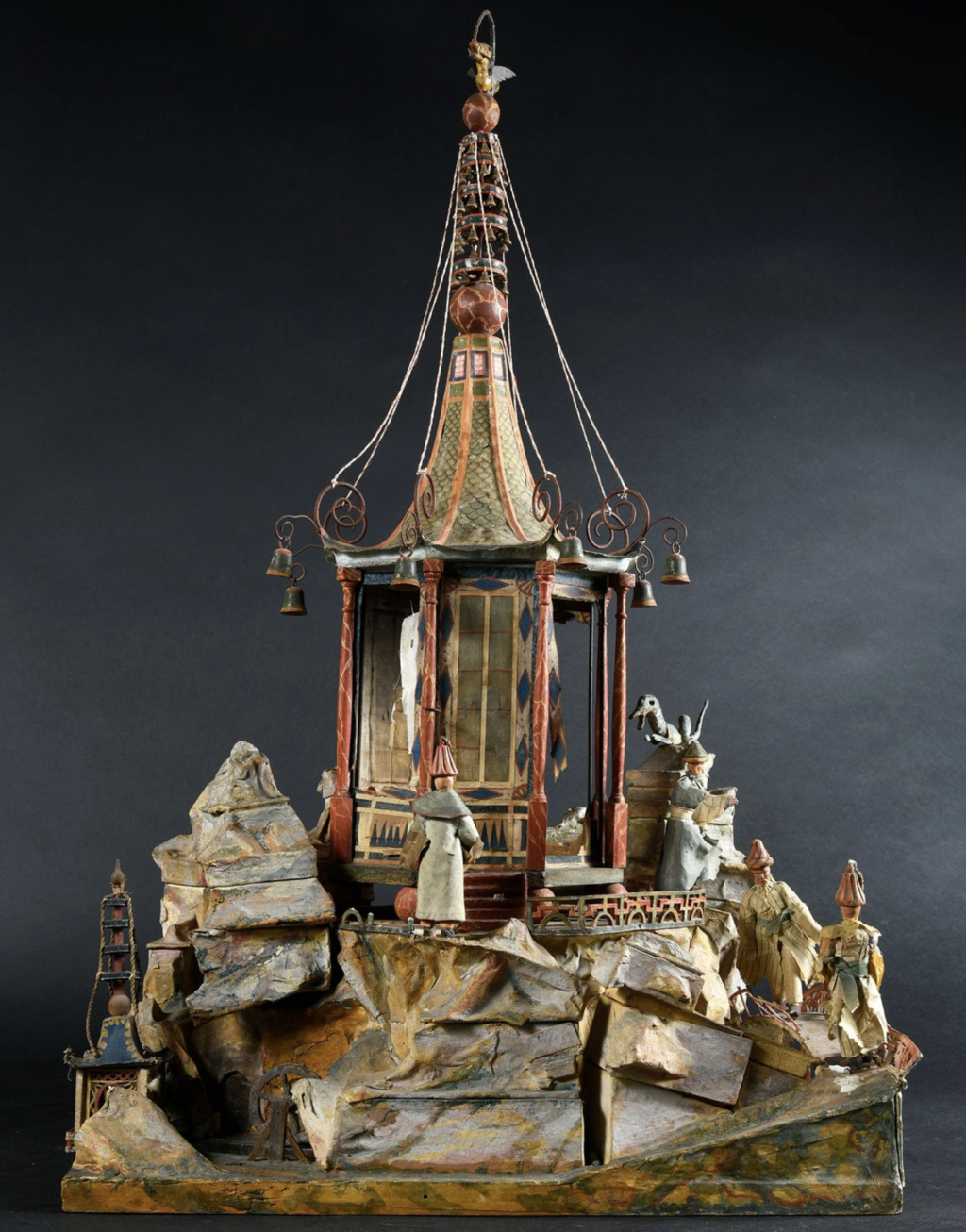

Présentation au catalogue
Un kiosque chinois s'élevait également dans le jardin de l'Hôtel de Montmorency-Luxembourg, en bordure du boulevard Montmartre ; cet hôtel, [...] avait été construit en 1704, entre la rue Saint-Marc et le Boulevard, par Lassurance, pour Thomas de Rivié, Secrétaire du Roi, qui y eut pour successeurs, d'abord en 1714, le contrôleur des Finances Desmarets, puis en 1728, le duc de Montmorency-Luxembourg ; depuis le commencement du XIXe siècle, cet hôtel a fait place au Passage des Panoramas et au Théâtre des Variétés.
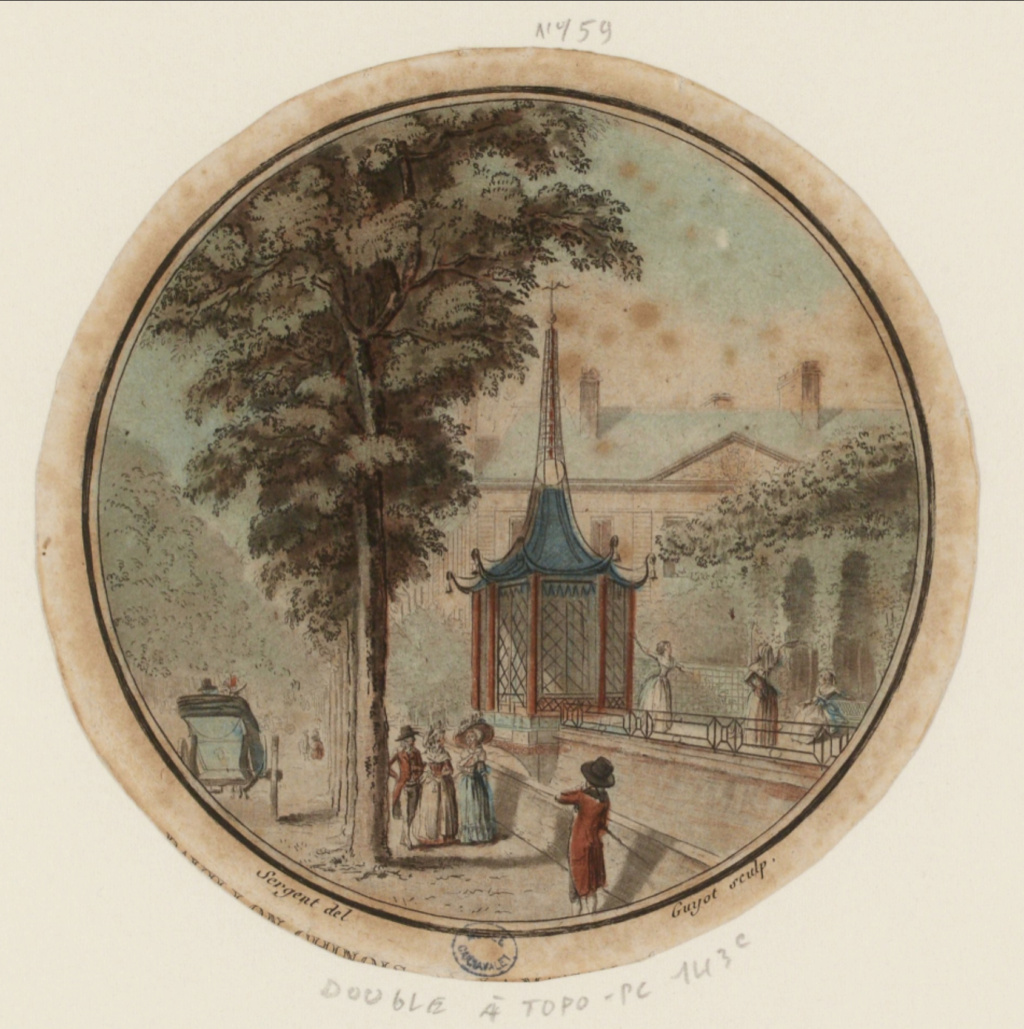
Ce pavillon octogonal, à toiture relevée aux angles à la chinoise, était probablement en fer et servait sans doute à lorgner le beau monde défilant sur le boulevard.
Ce pavillon est suffisamment remarquable pour être reproduit de nombreuses fois ; dans les Vues pittoresques de Paris, sous le n°59 (médaillon de la p. 4) ; dans le Voyage pittoresque de la France (gravure de Lallemand, p. 4, et détail du même p. 6) et dans les cahiers de Le Rouge recensant les Jardins anglo-chinois.

Vue de l'hotel de Montmorency et du pavillon chinois
Jean-Baptiste Lallemand
Dessin, gouache
XVIIIe siecle
Image : Bibliothèque nationale de France, département Estampes et photographie
Mais que penser de cette maquette, me direz-vous ?
Est-ce une maquette de présentation, que le sieur Rousseau, fournisseur habitué de la maison Montmorency aurait préparée pour décrire son projet en trois dimensions et ainsi emporter le marché ?
Mais alors qu'en est-il des boîtes empilées les unes sur les autres, remplaçant astucieusement les rocailles d'un environnement sauvage ?


Serait-ce plutôt un jeu de devinettes ? D'où la présence de ces nombreuses boîtes celant douceurs, sucreries, mais aussi sans doute, colifichets, bijoux et autres menus plaisirs.
La base même de la pagode, sert de cachette à un objet un peu plus volumineux, que l'on se plait à imaginer...
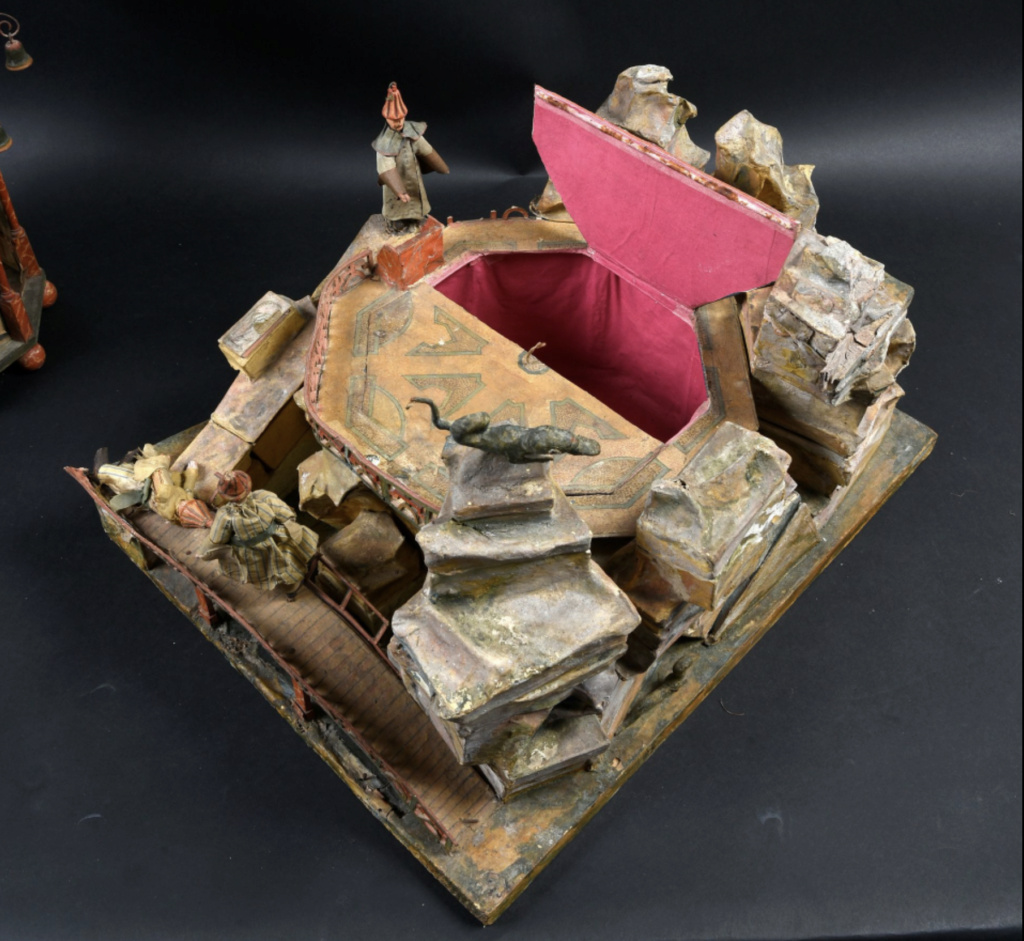
* Source et infos complémentaires : Coutau-Bégarie & Associés - Vente du 19 octobre 2021
Maquette du Pavillon chinois de l'hôtel de Montmorency-Luxembourg
Atelier d'architecture de Pierre ROUSSEAU, Paris - vers 1770/1780
Dimensions : Hauteur totale 850mm - Base 510 x 405 mm
Bel état de conservation général, présence de toutes les boîtes et des personnages habillés. Certaines des bannes (percale et papier) occultant les baies de la folie sont endommagées.



Présentation au catalogue
Un kiosque chinois s'élevait également dans le jardin de l'Hôtel de Montmorency-Luxembourg, en bordure du boulevard Montmartre ; cet hôtel, [...] avait été construit en 1704, entre la rue Saint-Marc et le Boulevard, par Lassurance, pour Thomas de Rivié, Secrétaire du Roi, qui y eut pour successeurs, d'abord en 1714, le contrôleur des Finances Desmarets, puis en 1728, le duc de Montmorency-Luxembourg ; depuis le commencement du XIXe siècle, cet hôtel a fait place au Passage des Panoramas et au Théâtre des Variétés.

Ce pavillon octogonal, à toiture relevée aux angles à la chinoise, était probablement en fer et servait sans doute à lorgner le beau monde défilant sur le boulevard.
Ce pavillon est suffisamment remarquable pour être reproduit de nombreuses fois ; dans les Vues pittoresques de Paris, sous le n°59 (médaillon de la p. 4) ; dans le Voyage pittoresque de la France (gravure de Lallemand, p. 4, et détail du même p. 6) et dans les cahiers de Le Rouge recensant les Jardins anglo-chinois.

Vue de l'hotel de Montmorency et du pavillon chinois
Jean-Baptiste Lallemand
Dessin, gouache
XVIIIe siecle
Image : Bibliothèque nationale de France, département Estampes et photographie
Mais que penser de cette maquette, me direz-vous ?
Est-ce une maquette de présentation, que le sieur Rousseau, fournisseur habitué de la maison Montmorency aurait préparée pour décrire son projet en trois dimensions et ainsi emporter le marché ?
Mais alors qu'en est-il des boîtes empilées les unes sur les autres, remplaçant astucieusement les rocailles d'un environnement sauvage ?


Serait-ce plutôt un jeu de devinettes ? D'où la présence de ces nombreuses boîtes celant douceurs, sucreries, mais aussi sans doute, colifichets, bijoux et autres menus plaisirs.
La base même de la pagode, sert de cachette à un objet un peu plus volumineux, que l'on se plait à imaginer...


* Source et infos complémentaires : Coutau-Bégarie & Associés - Vente du 19 octobre 2021

La nuit, la neige- Messages : 17779
Date d'inscription : 21/12/2013
 Re: Boites, tabatières, montres, étuis et autres objets précieux du XVIIIe siècle
Re: Boites, tabatières, montres, étuis et autres objets précieux du XVIIIe siècle
Je ne résiste pas à poster ici ces belles images de l'un des chefs-d'oeuvre qui sont conservés au musée Cognacq-Jay que nous connaissons bien ici... 
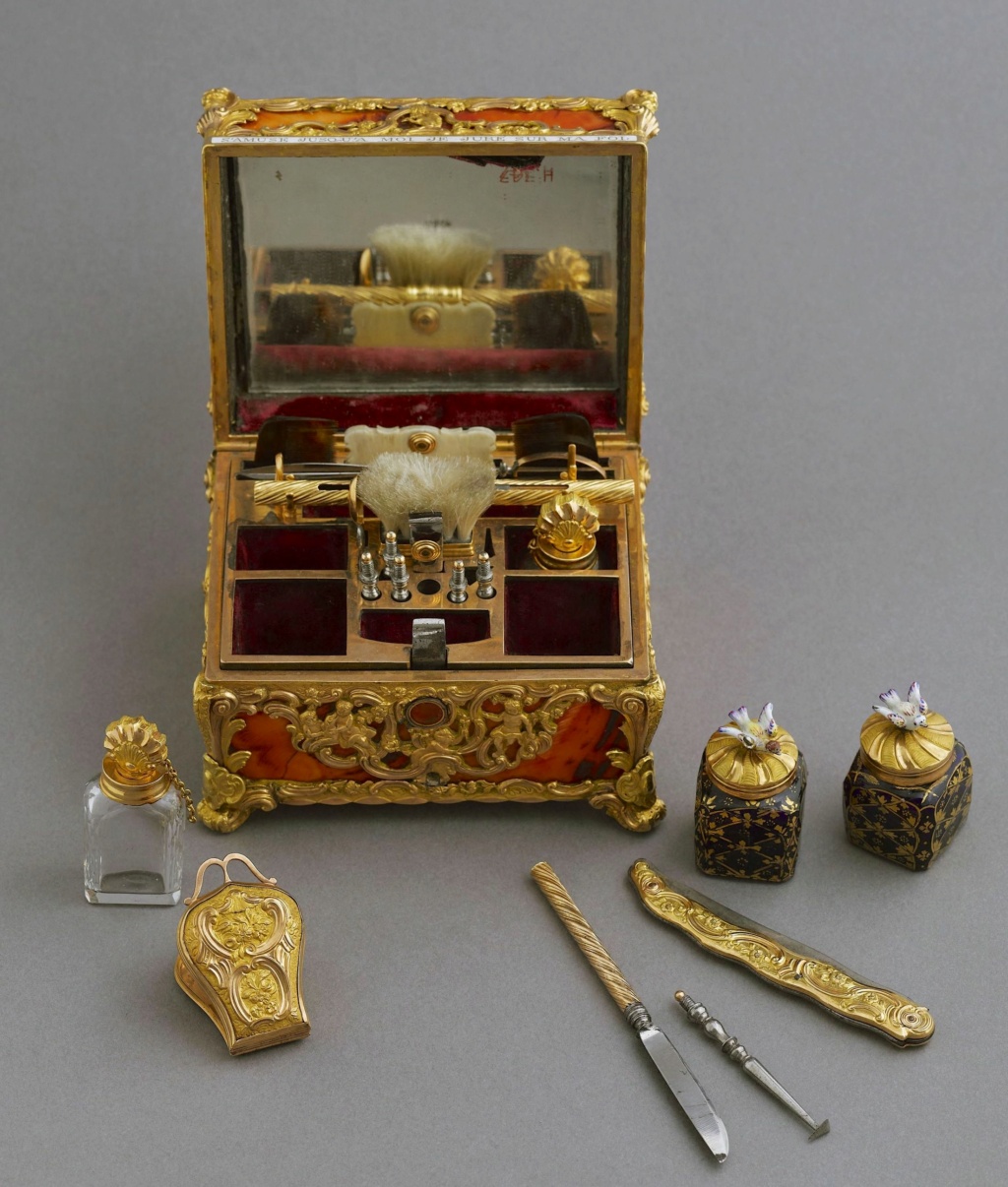
Coffret-nécessaire
Attr. James Cox (1749-1792)
Entre 1760 et 1770
Or, Agate, Email, Bois, Velours
H. 13.8 cm x l. 10 cm x P. 8 cm ; P. 410 g
Mouvement de la montre signé : "Granthom, London, 3456"
Inscription sur la ceinture, en lettres d'or sur émail opaque blanc : "Si en m'ouvrant, votre pensée / S'amuse jusqu'à moi / Je jure sur ma foi, / Je serai bien récompensée."
Image : Musée Cognacq-Jay, Paris
Présentation du musée
La signature du cadran de la montre "Granthom London" confirme l'attribution de ce nécessaire aux ateliers anglais dont les plus célèbres furent ceux de James Cox.
D’origine étrangère, l'inscription « Si en m'ouvrant, Votre pensée s'amuse jusqu'à moi, je jure sur ma foi, Je serai bien récompensée » suggère, en français un cadeau sentimental.
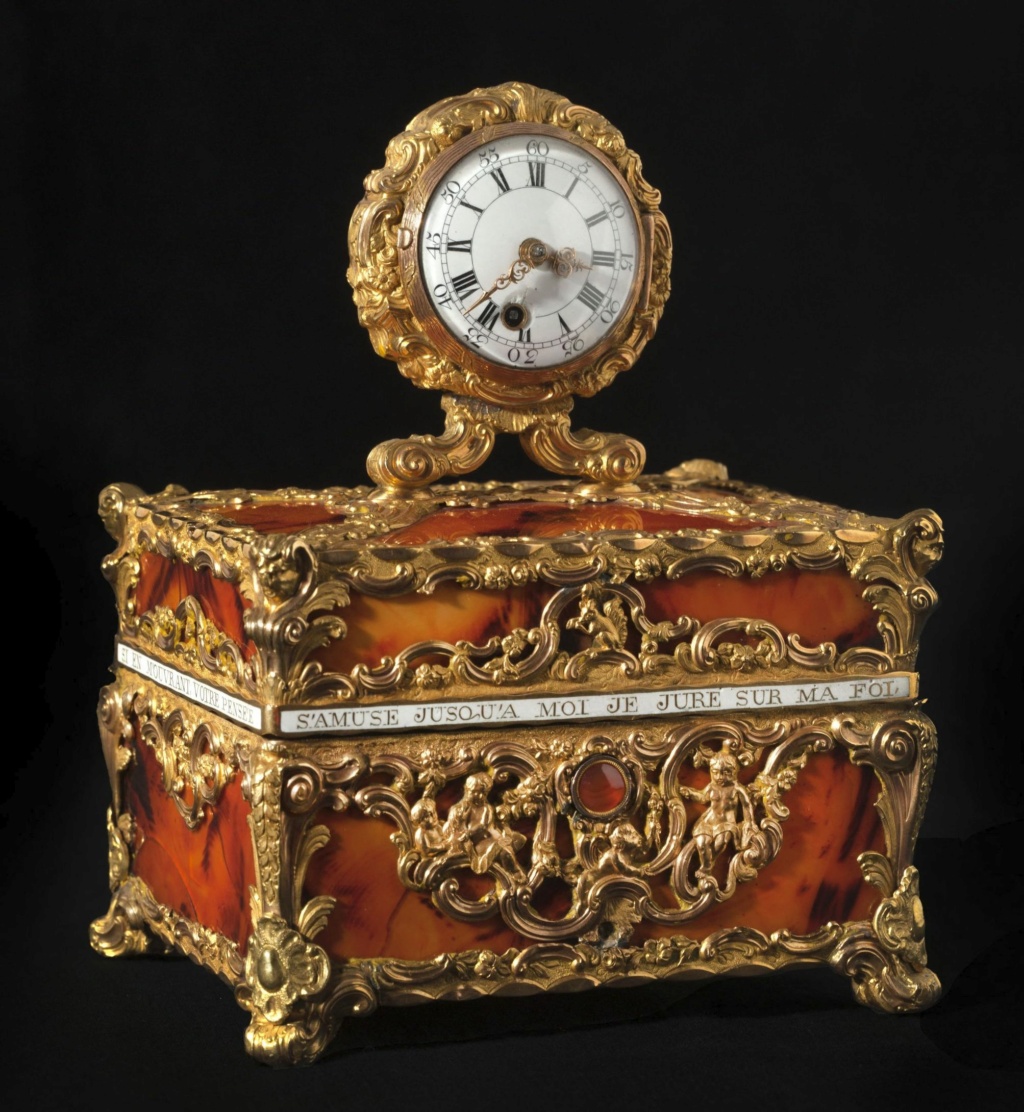

Images : Musée Cognacq-Jay, Paris
L'ouverture de ce coffret révèle une merveille d'ingéniosité. Les usages de ces objets varient, mais ils ressortissent tous des us et coutumes d’un quotidien raffiné. Ils servent à la toilette féminine (boîte à mouches ou à rouge, coffret à parfum, étui porte-lacet..), à la pratique d’occupations privilégiées de l’élite, comme l’écriture (nécessaire à écrire, étui à cire pour cacheter les lettres...) ou encore aux nouveaux plaisirs de bouche.
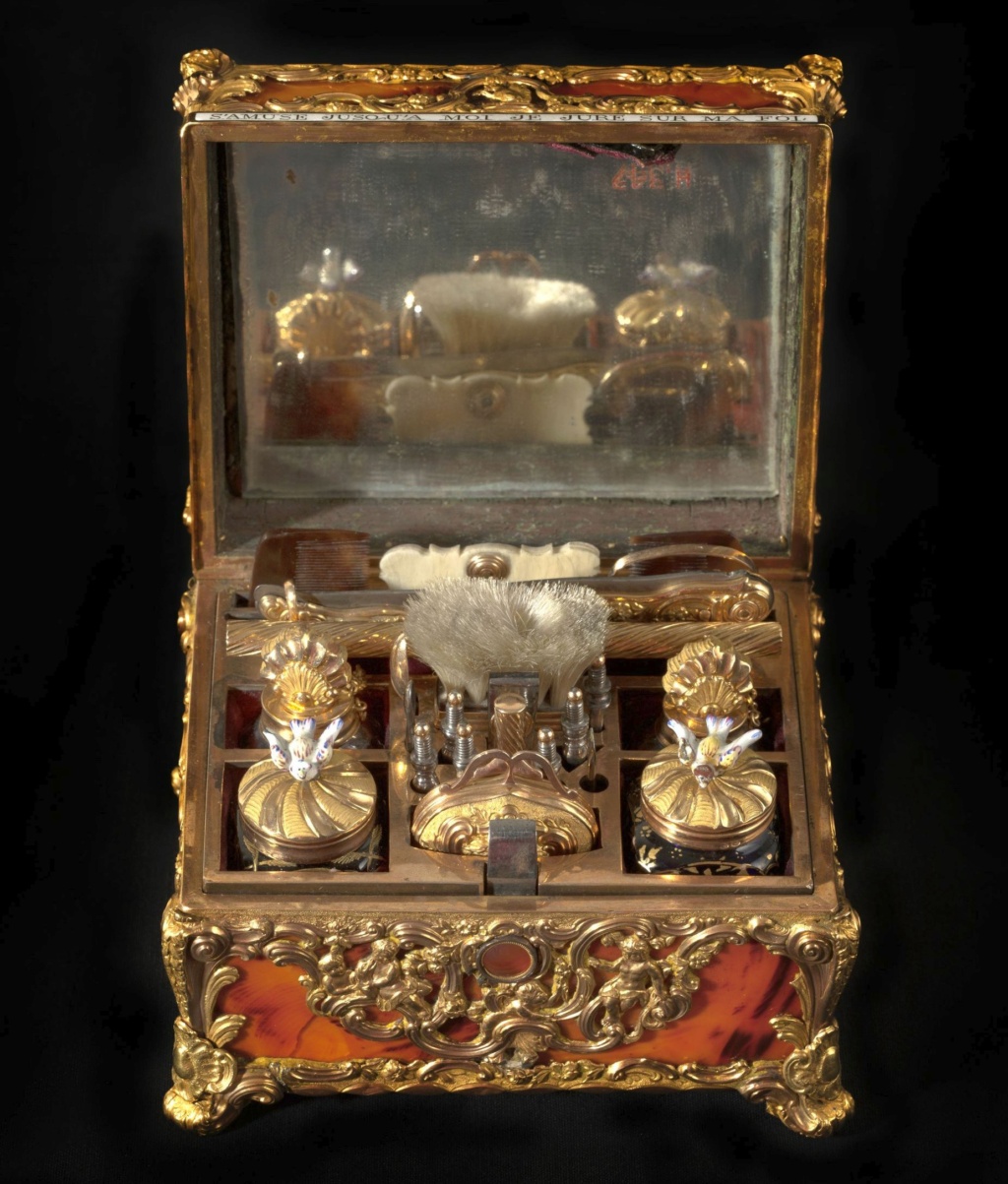

Images : Musée Cognacq-Jay, Paris
En effet, ce ne sont pas moins de 19 petits instruments qui sont logés dans des compartiments faits aux dimensions de chacun d'entre eux : flacons dont le bouchon adopte tantôt la forme d'une coquille en or tantôt celle d'un oiseau en porcelaine polychrome de Chelsea, tablettes à écrire en ivoire avec leur crayon, grattoir et coupe-papiers, objets de toilette divers (peignes, brosse, passe-lacets, repousse-peau...). Trop petits pour être bien tenus en main, ceux-ci venaient se visser sur un petit manche en or torsadé.

Images : Musée Cognacq-Jay, Paris
* Source et infos complémentaires : Musée Cognacq-Jay - Les chefs-d'oeuvre, coffret-nécessaire
 J'ignore le pourquoi de ces dates de naissance et de mort précisées ci-dessus par le musée
J'ignore le pourquoi de ces dates de naissance et de mort précisées ci-dessus par le musée  , mais je suppose qu'il s'agit d'une erreur et je vous renvoie à la contemplation de quelques-uns des chefs-d'oeuvre de joaillerie et d'horlogerie de James Cox dans notre sujet :
, mais je suppose qu'il s'agit d'une erreur et je vous renvoie à la contemplation de quelques-uns des chefs-d'oeuvre de joaillerie et d'horlogerie de James Cox dans notre sujet :
 Pendules, automates, coffrets et autres objets précieux de l'horloger-joaillier James Cox (1723-1800)
Pendules, automates, coffrets et autres objets précieux de l'horloger-joaillier James Cox (1723-1800)
Amateurs d'épure minimaliste, passez votre chemin !


Coffret-nécessaire
Attr. James Cox (1749-1792)
Entre 1760 et 1770
Or, Agate, Email, Bois, Velours
H. 13.8 cm x l. 10 cm x P. 8 cm ; P. 410 g
Mouvement de la montre signé : "Granthom, London, 3456"
Inscription sur la ceinture, en lettres d'or sur émail opaque blanc : "Si en m'ouvrant, votre pensée / S'amuse jusqu'à moi / Je jure sur ma foi, / Je serai bien récompensée."
Image : Musée Cognacq-Jay, Paris
Présentation du musée
La signature du cadran de la montre "Granthom London" confirme l'attribution de ce nécessaire aux ateliers anglais dont les plus célèbres furent ceux de James Cox.
D’origine étrangère, l'inscription « Si en m'ouvrant, Votre pensée s'amuse jusqu'à moi, je jure sur ma foi, Je serai bien récompensée » suggère, en français un cadeau sentimental.


Images : Musée Cognacq-Jay, Paris
L'ouverture de ce coffret révèle une merveille d'ingéniosité. Les usages de ces objets varient, mais ils ressortissent tous des us et coutumes d’un quotidien raffiné. Ils servent à la toilette féminine (boîte à mouches ou à rouge, coffret à parfum, étui porte-lacet..), à la pratique d’occupations privilégiées de l’élite, comme l’écriture (nécessaire à écrire, étui à cire pour cacheter les lettres...) ou encore aux nouveaux plaisirs de bouche.


Images : Musée Cognacq-Jay, Paris
En effet, ce ne sont pas moins de 19 petits instruments qui sont logés dans des compartiments faits aux dimensions de chacun d'entre eux : flacons dont le bouchon adopte tantôt la forme d'une coquille en or tantôt celle d'un oiseau en porcelaine polychrome de Chelsea, tablettes à écrire en ivoire avec leur crayon, grattoir et coupe-papiers, objets de toilette divers (peignes, brosse, passe-lacets, repousse-peau...). Trop petits pour être bien tenus en main, ceux-ci venaient se visser sur un petit manche en or torsadé.

Images : Musée Cognacq-Jay, Paris
* Source et infos complémentaires : Musée Cognacq-Jay - Les chefs-d'oeuvre, coffret-nécessaire
___________________
Amateurs d'épure minimaliste, passez votre chemin !



La nuit, la neige- Messages : 17779
Date d'inscription : 21/12/2013
 Sujets similaires
Sujets similaires» Boites, tabatières et autres objets précieux en micro-mosaïque
» Pendules, automates, coffrets et autres objets précieux de l'horloger joailler James Cox (1723-1800)
» Exposition : Luxe de poche - Petits objets précieux au siècle des Lumières. Musée Cognacq-Jay
» Soins de beauté, maquillage, et mouches au XVIIIe siècle
» Exposition : Jewels ! Glittering at the Russian Court, Hermitage Amsterdam
» Pendules, automates, coffrets et autres objets précieux de l'horloger joailler James Cox (1723-1800)
» Exposition : Luxe de poche - Petits objets précieux au siècle des Lumières. Musée Cognacq-Jay
» Soins de beauté, maquillage, et mouches au XVIIIe siècle
» Exposition : Jewels ! Glittering at the Russian Court, Hermitage Amsterdam
LE FORUM DE MARIE-ANTOINETTE :: La France et le Monde au XVIIIe siècle :: Les Arts et l'artisanat au XVIIIe siècle :: Autres
Page 1 sur 1
Permission de ce forum:
Vous ne pouvez pas répondre aux sujets dans ce forum